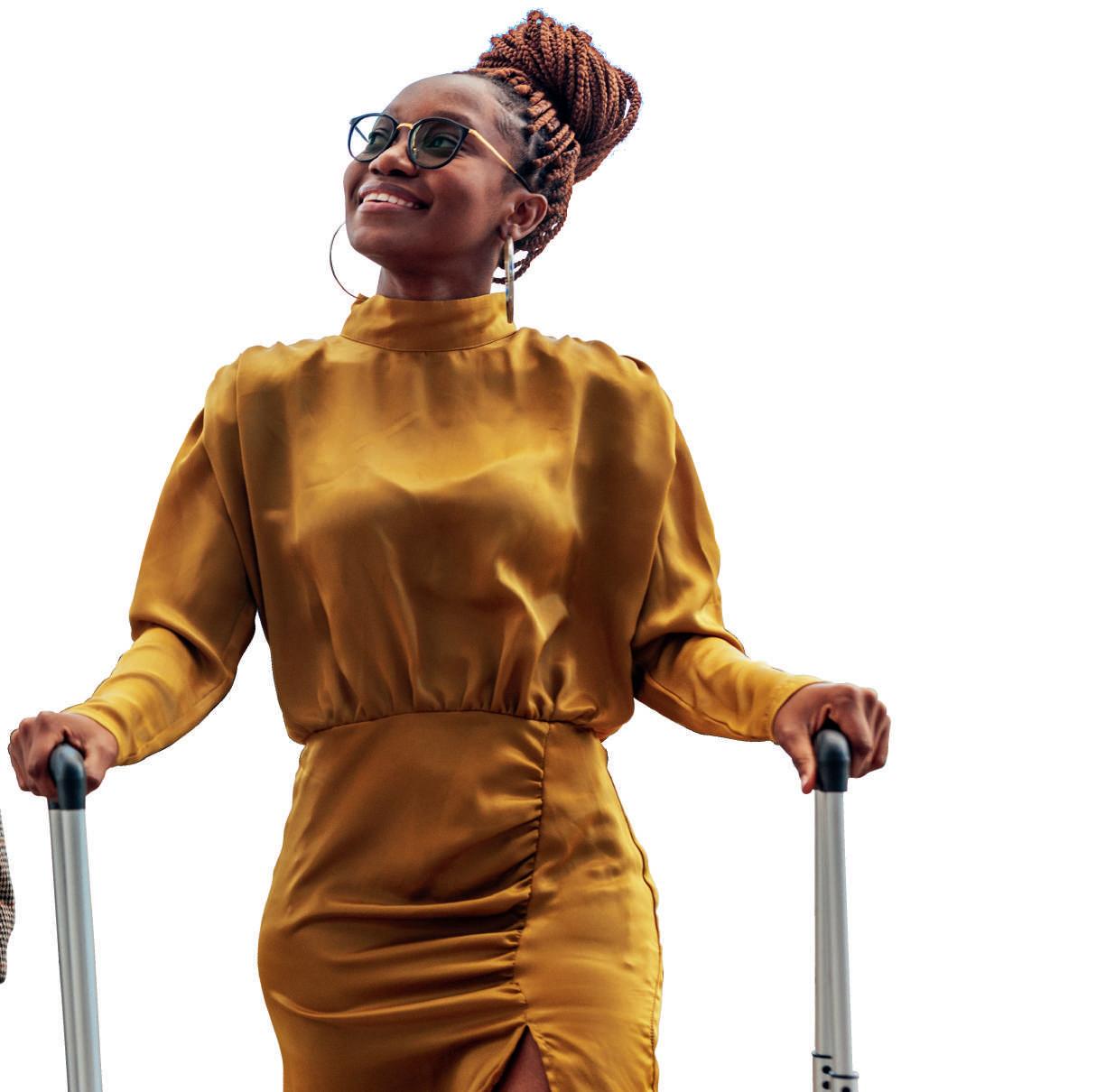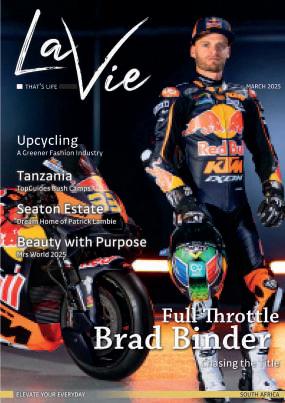La

Fashion & The Fight Against Fakes
Addressing The ‘O Face’ Epidemic
The New BYD Shark
F45 Training
Stay Active Indoors



Fashion & The Fight Against Fakes
Addressing The ‘O Face’ Epidemic
The New BYD Shark
F45 Training
Stay Active Indoors

Your ultimate comfort cocoon awaits. When temperatures drop, skin needs extra TLC. Wrap yourself in warmth with these rich, nourishing body heroes from The Body Shop – chosen to soothe, protect, and indulge.



From deep hydration to daily defence, these facial skincare favourites from The Body Shop work overtime to protect and perfect your complexion through the winter months.
Vitamin E Bi-phase Serum
Hydrate like a hero. This lightweight serum is enriched with vitamin E and hyaluronic acid to boost moisture and leave skin feeling smooth


Lip care: A nourishing little number for lips in need
Say farewell to chapped lips with this ultra-moisturising balm.
Skin defence multiprotection lotion SPF50+ invisible armour.

Yes, you need SPF in winter too. This lightweight daily lotion shields against UVA/UVB rays and pollution


Vitamin c glow boosting moisturiser revive dull winter skin
This lightweight gel-cream moisturiser is a game-changer for tired, dull-looking skin.

sheet mask: edelweiss or vitamin c spa night essential
Pressed for time but craving a glow-up? These biodegradable sheet masks are infused with potent skincare ingredients


As winter wraps itself around South Africa, there’s something beautifully grounding about the slower pace the season brings. June invites us to pause, reflect, and reconnect - with ourselves, our spaces, and the people who warm our lives. In this issue of La Vie, we embrace that spirit of winter with stories that celebrate both stillness and adventure.
From the snow-dusted peaks of the Drakensberg to the roaring fireplaces of the Winelands, South Africa reveals a quieter, more introspective kind of beauty in the colder months. Whether you’re chasing misty mountain trails, curling up with a book and a blanket, or hosting intimate dinners with friends, our pages are filled with inspiration to make the most of this season.
We explore winter wellness that nourish both body and mind, stylish yet functional home décor to transform your space, and the rich textures of cold-weather fashion with a distinctly South African flair.
This issue also honours the power of community - those warm connections that sustain us through long nights and early frosts. Whether it’s through food, shared stories, or quiet rituals, winter is a time to draw inward while holding each other close.
As always, thank you for bringing La Vie into your home. May this issue inspire you to find beauty in the chill, joy in the quiet, and a renewed sense of self as we move through the heart of the year.
Warm regards,




Freshen up your look with the Full Brow Liners by RefectoCil® – eyebrow pencils and highlighter designed to enhance your professional brow & lash styling.
The Full Brow Liners by RefectoCil®, with their silky texture and ultra-fine tip, deliver precise, smudge-proof, waterproof definition that lasts up to 10 hours.
Available in three natural shades: Light, Medium, and Dark Brown.
BYE-BYE WRINKLES AND FACELIFTS, HELLO BEAUTIFUL!
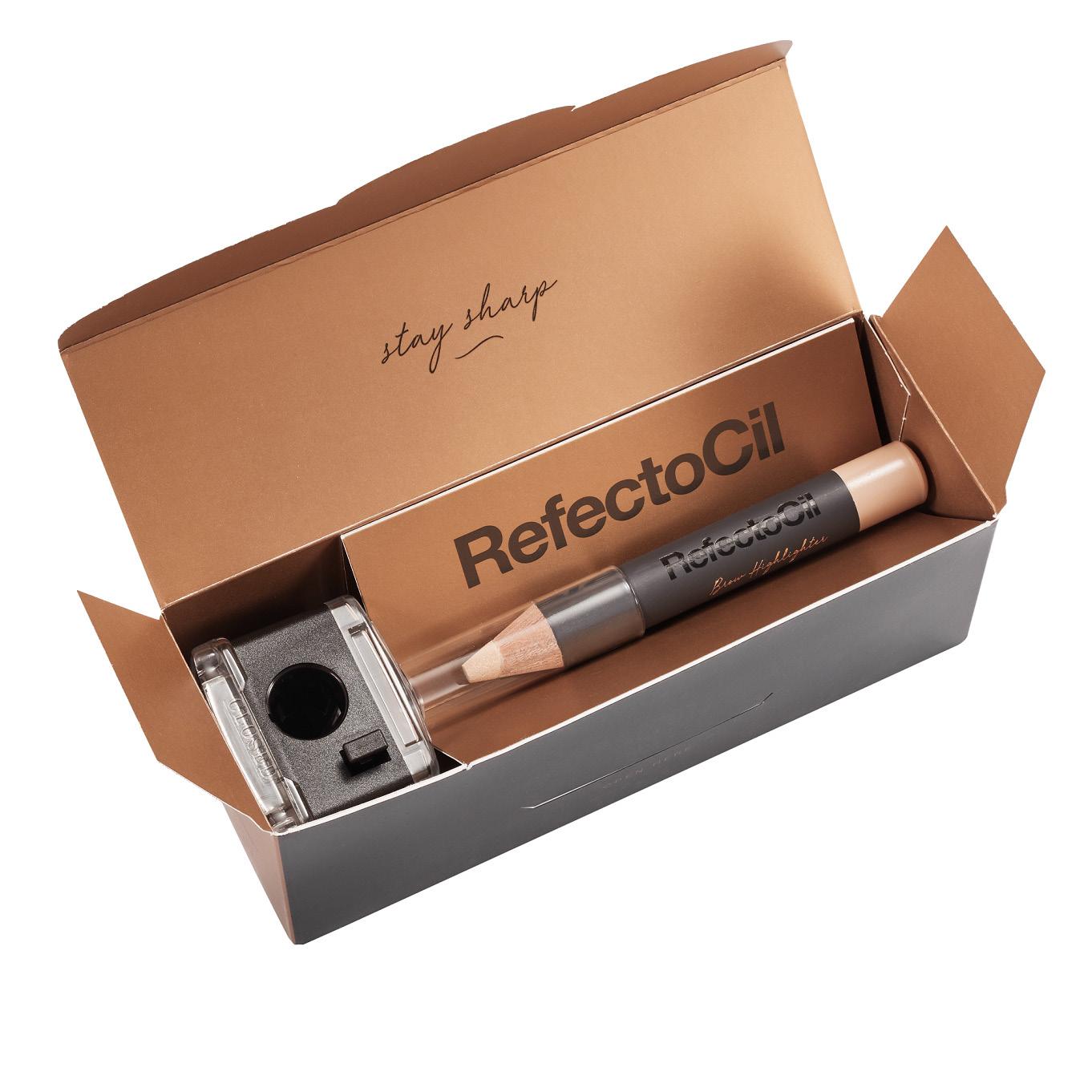
People all over the world are turning to collagen as a natural option for anti-aging so they can look their best without invasive procedures. The collagen used for beauty, type I collagen, is one of the world’s most soughtafter and trusted anti-aging supplements because it has the power to revitalize your skin, hair and nails as you age. Award-winning Collagen Lift® Paris RED CARPET is more than just your average collagen powder or tablet. Made in France, it is backed by seven clinical trials and proven to reduce wrinkles by up to 50%, improve skin hydration and elasticity, improve hair and nails and reduce cellulite. The liquid formula contains a powerful combination of collagen, hyaluronic acid, seaweed and vitamin C which work together to give you plumper, firmer, youngerlooking skin and beautiful hair and nails. Known for its quality and results, RED CARPET reduces the signs of aging naturally without anyone knowing your secret. Collagen certified Halaal and Kosher Available at Dis-Chem and Medirite+ Plus Pharmacies countrywide and online on Takealot and www.collagenliftparis.co.za @collagenlift_sa
Brighten and lift your look with the Brow Highlighter Set by RefectoCil® – its soft shimmer and optical lifting effect open up your eyes for a radiant, wide-awake finish that lasts up to 8 hours. Includes a specially designed sharpener.
Let your eyes bloom this spring with the Full Brow Liners by RefectoCil® – because fresh brows are always in season.
Recommended Retail Prices: Brow Highlighter Set by RefectoCil® R410.00
Full Brow Liners by RefectoCil® R 245.00 (available in 3 shades, Light (01), Medium (02) & Dark Brown (03))
All products are available from Takealot.com or Professional Distributors listed on www.refectocil.co.za


6: Tech & Lifestyle Luxury innovations taking flight in 2025
10: Cover Story Maps Maponyane: Redefining luxury through purpose
14: Fashion & Beauty Winter skincare regime
20: Home & Design Maximalism design
26: Wellness Wisdom Staying active indoors with F45 Training
32: Travel & Leisure Winter adventure activities
36: Food & Drink Winter wines & spirits
42: Motoring The BYD Shark
Publisher & Editor
Wanita Wallace
wanita@laviemag.co.za editor@laviemag.co.za
Tech Editor
Clare Petra Matthes www.gadgetgal.com
Graphic Designer (Contributing)
Bryan Maron www.designbandits.co.za
Advertising Sales Executive
Preni Sukdeo preni(@laviemag.co.za

46: Travel Diary Into the mist: Gorilla trekking in Rwanda
50: Home Tour
A celebration of soul, style & setting
56: Culinary Corner Biru restaurant: A feast of fire & flavour
60: Spotlight Elunda Basson: The vine, the vision & the voice
64: In the Know Fashion & the fight against fakes
68: Trend Report The ‘O face’ epidemic
70: Events & Happenings

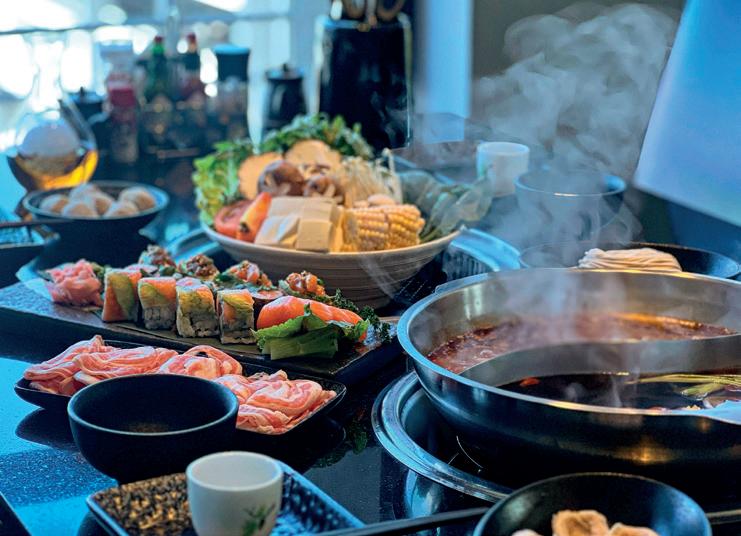

Red Cat Media (PTY) Ltd
Registration number: 2024/497973/07
20 Sandton Close 17 Alexander Avenue Fourways, 2191
Contact: +27 (0)71 678 2784 info(@laviemag.co.za www.laviernag.co.za

F45 is for high-performers who want more out of their training. Coach-led, community-driven, and backed by sports science. You don’t need to think — you just need to show up.
JOIN NOW
Start with a free 7-day trial


By Clare Petra Matthes
Gadgets today are not only about exclusivity, they’re also about intelligent design, elevated experiences, and the seamless integration of tech into a refined lifestyle. Whether in the skies or on your wrist, innovation is making the everyday more inspired.

Meanwhile, back on the ground, and around your wrist, Huawei is pioneering new dimensions of interactive design with the upcoming Watch 5, launching in South Africa this June. Designed for those who value both wellness and aesthetic, the Watch 5 introduces a highly intelligent TruSense System with fingertip health monitoring powered by Multi-sensing X-TAP Technology.
The result? More accurate health insights with less effort. Add to that intuitive gesture controls (like “Double Tap” and “Double Slide”) and new luxury tones — Purple and Sand Gold — and it becomes clear: the Watch 5 is as much a style statement as it is a smart device.
The Watch 5 will be available in South Africa from 2 June online, and from July in select retailers, starting at R9 999.
Alongside it, Huawei has also introduced the Watch Fit 4 Pro — ultra-slim, adventure-ready, and ideal for discerning fitness lovers — as well as the new FreeBuds 6 and MatePad Pro 12.2-inch, all maintaining the brand’s now-signature blend of innovation and elegance.

Qatar Airways: Gaming at 35,000 Feet
Setting a new benchmark for in-flight innovation, Qatar Airways recently hosted the world’s first e-sports tournament in the sky, a headline event called “Gaming in the Sky”, powered by Starlink’s highspeed satellite connectivity. The spectacle unfolded mid-flight earlier this year, during a journey from Doha to London, with global gaming icons like Tfue, Alodia Gosiengfiao, and Castro1021 competing live at cruising altitude.
Two teams, namely Burgundy Oryx and Grey Aviators, engaged in a real-time showdown streamed across Qatar Airways’ social channels. The event was more than entertainment; it marked the airline’s bold leap into the future of luxury travel. With plans to outfit its Boeing 777 and Airbus A350 fleets with complimentary Starlink Wi-Fi, Qatar Airways is making streaming, gaming, and working inflight as seamless as it is on the ground.
For tech-forward flyers, this is the new gold standard.
HONOR 400 Lite: Everyday innovation, elevated
For the luxury lover who’s also a content creator or multitasker, the soon-to-arrive Honor 400 Lite might be one of the most intelligent Android smartphones to debut this year.
Building on the success of the Honor 200 Lite, the 400 Lite adds a game-changing feature: the AI Camera Button — the first of its kind on Android.
This dedicated hardware button lets users snap, search, translate, or erase objects in photos instantly, even with gloves on.
Backed by Google Lens and Geminipowered tools like AI Eraser and Outpainting, it offers powerful editing in the palm of your hand. A stunning 108MP main camera, vibrant AMOLED display, and stylish finishes in Mars Green and Velvet Grey make it a head-turning accessory in its own right.





In 2025, the line between technology and everyday living continues to blur. Innovations once imagined in science fiction are now part of daily routines, while lifestyle habits are evolving in response to a rapidly changing world.
Beyond tech, people are rethinking how they live and work. Sustainability is no longer a niche concern - it’s central. From clothing to home décor, consumers are choosing eco-friendly materials and second-hand items to reduce waste. Home designs are focused on wellness, with natural materials, greenery, and minimalist aesthetics leading the way.
Digital fatigue is also shaping lifestyle choices. Many are turning to “digital detoxes,” carving out techfree time to reconnect with nature, hobbies, or in-person social activities. In a fast-moving digital world, slowing down has become a conscious act of self-care.

One of the most significant developments this year is the rise of intelligent, proactive AI systems - also called “agentic AI.” These tools don’t just respond to commands; they act independently, anticipating needs and solving problems before users even ask. Think of virtual assistants that schedule meetings, reorder groceries, or filter emails with minimal input. This shift is accompanied by “ambient intelligence” - technology
that fades into the background while quietly making our environments more responsive. Smart homes, for example, adjust lighting, climate, and even music based on your mood or habits.
Meanwhile, robotics is undergoing a transformation. New-generation robots are no longer single-task machines. They’re now capable of handling a range of tasks, from cooking to healthcare assistance - making them ideal companions in both homes and workplaces.
The traditional 9-to-5 is being replaced by flexible work models. People are embracing freelance gigs, passion projects, and side hustles, valuing freedom over stability. This shift reflects a deeper cultural move toward autonomy and purpose-driven work.
In fashion and entertainment, nostalgia reigns. ‘90s and early 2000s trends are back, reinterpreted with a modern twist. And for many - especially Gen Z - shopping is driven by emotion and personal expression rather than practicality.
In short, 2025 is all about intentionality - using technology to enhance life, not overwhelm it, and building lifestyles rooted in sustainability, flexibility, and authenticity. LV
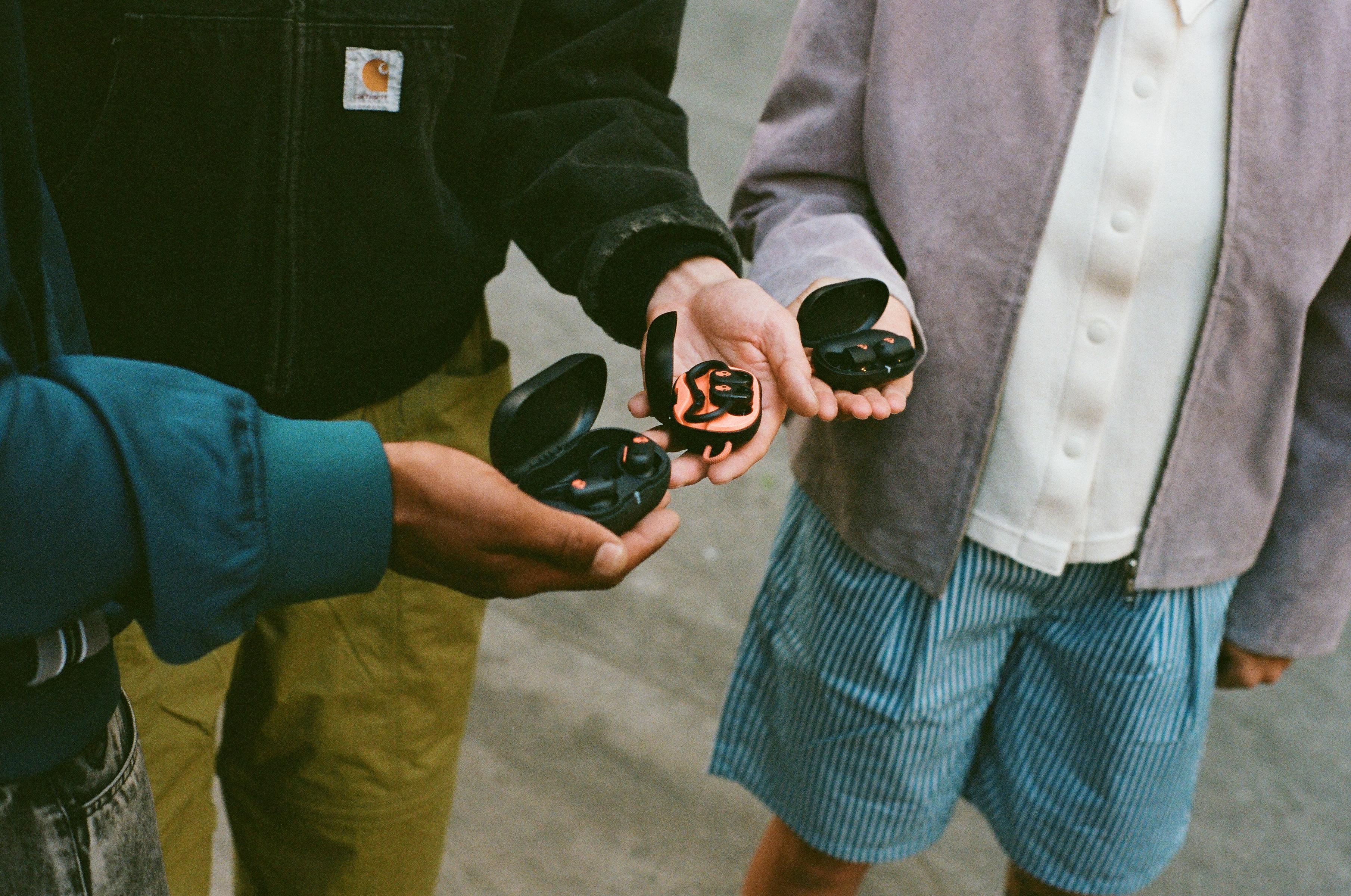
What initially drew you to the Glenfiddich Challengers Club campaign, and how does it align with your personal values?
I’ve always believed in pushing boundaries and using my platform for meaningful change, so the Glenfiddich Challengers Club felt like a perfect fit. I started on this journey with the brand in 2020. This campaign isn’t just about whiskyit’s about storytelling, impact and challenging conventions. When Glenfiddich invited me on this journey, I knew it was an opportunity to highlight something bigger than myself: the importance of water and the role it plays in both craftsmanship and communities.
You’ve travelled to Iceland, Scotland, and Matatiele for this campaign. What was the most eyeopening moment for you during these journeys?

Maps Maponyane is no stranger to breaking boundaries. From media to philanthropy, his multifaceted career has always centred on meaningful impact. In this Q&A interview with La Vie, Maps shares the deeply personal journey he embarked on with Glenfiddich’s Challengers Club campaign - a project that took him from the pristine glaciers of Iceland to the highlands of Scotland, and finally to the rural heart of Matatiele, South Africa. More than just a brand collaboration, the campaign ignited a conversation around water conservation, access, and the power of storytelling to spark tangible change. As he reflects on the transformative experiences and the communities he encountered, Maps invites us to reimagine what it means to live, lead, and enjoy with purpose.
Each destination told a different story, but the culmination of this campaign ending in Matatiele and seeing first-hand how a community’s entire reality can change by just gaining access to clean water. I started on this journey to Iceland, trekking to find the pursuit of untouched water, but now witnessing the transformation in Matatiele shows me what true impact looks like. It’s humbling that something as simple as water - something we often take for granted is live-changing.
As someone who has worn many hats - entrepreneur, media personality, philanthropist - how does your work in this campaign fit into your broader mission?
At the core of everything I do, I want to
inspire people to take action - whether in business, personal growth or social responsibility. This campaign is an extension of this. It’s shown me the power of using storytelling to drive real-world change. The fact that Glenfiddich didn’t just tell the story of untouched water but actively built a sustainable water solution in Matatiele aligns perfectly with the type of work I strive to be a part of.
Water Conservation & Awareness
In your own words, why is water such an important issue, particularly in South Africa?
Water is life. It’s that simple. But in South Africa, where millions still struggle with access to clean water, it’s also a privilege that too many go without. The irony is that we have natural water sources, but contamination, infrastructure failures and
inequality mean that communities like Matatiele have been left behind. The conversation around water conservation needs to be more than just talk-it needs action and that is exactly what this last film is about.
Having seen both pristine water sources and communities struggling with water scarcity, how has your perspective on water changed?
It’s been a journey of contrast. In Iceland, I walked through untouched landscapes, surrounded by glaciers and water so pure it felt surreal. In Scotland, I saw how water is at the heart of craftsmanship of the World’s Most Awarded Whisky. And then, when it came to being presented with Matatiele, the brand saw people struggling for something so basic. The entire campaign has made me realise how interconnected we are-how our actions, whether in conserving or polluting water, have long-term consequences. The privilege of access should never be taken lightly.
What are some practical steps you think individuals and businesses can take to contribute to sustainable water solutions?
On an individual level, we need to be mindful of our consumption-simple habits like fixing leaks, reducing water waste and supporting sustainable initiatives all make a difference. On a corporate level, businesses need to step up and take responsibility. I feel that Glenfiddich has set a great example by not just talking about water conservation but actively help build infrastructure to help communities. Other brands should look at how they can make tangible contributions through their awareness campaigns.
Whiskey & Storytelling Glenfiddich is known for its purity and craftsmanship. Did your journey with the brand change the way you appreciate whiskey?
Absolutely. Before this journey, I enjoyed whisky but hadn’t fully appreciated the role water plays in shaping its character. Learning about the Robbie Dhu Spring in Scotland and how Glenfiddich has relied on this water source since 1886 gave me a new perspective. Water is the foundation of great whisky, just like it’s the foundation of life itself.

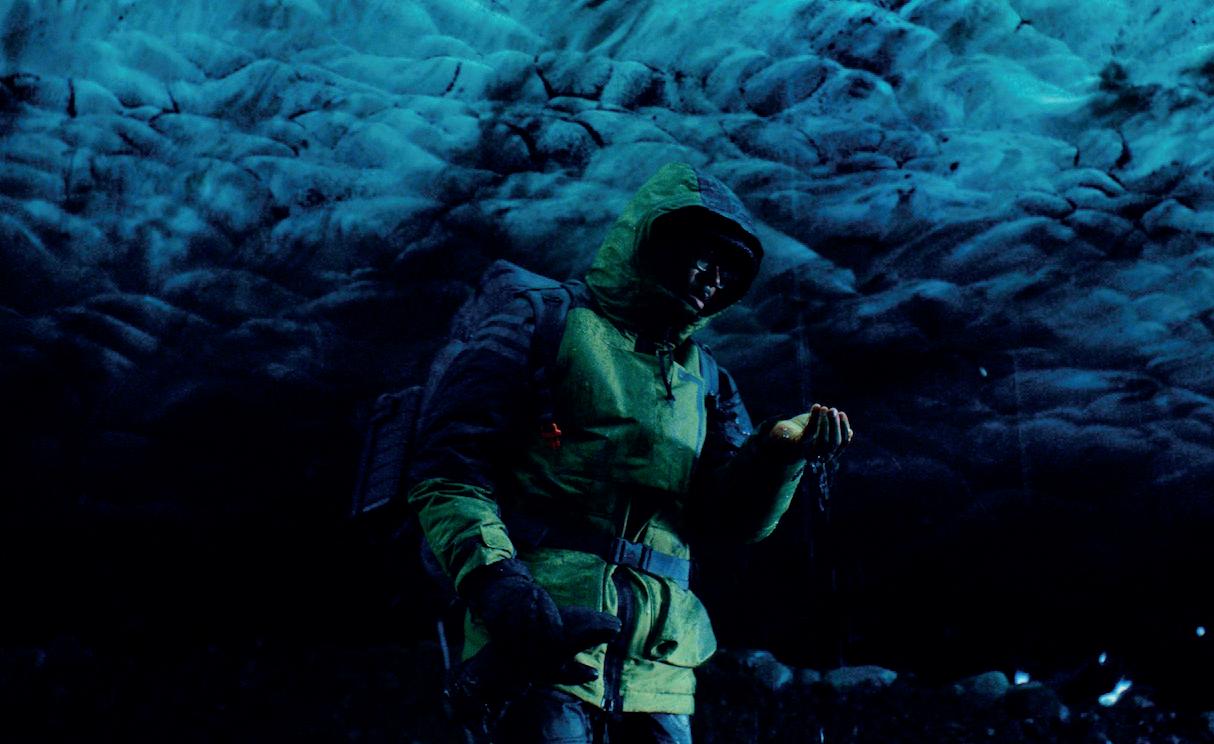
Now, every sip of Glenfiddich feels like a connection to that history and craftsmanship.
Storytelling is a powerful tool for change. How do you think the Challengers Club campaign has successfully used storytelling to inspire action?
The campaign has been about more than just visuals or narratives-it has made the audience feel something. By taking viewers from the untouched purity of Iceland to the whisky craftsmanship in Scotland and then to the raw reality of Matatiele, it has built a powerful contrast. It forces people to question their own relationship to water and more importantly what we can do to protect and sustain it. The best stories don’t just entertain; they challenge you to think and act differently.

Beyond this campaign, do you see yourself continuing to advocate for water conservation and sustainability?
This campaign has certainly opened my eyes to how urgent the issue is. I will continue to partner with initiatives that create real solutions. It is a cause that I will always carry forward.
What do you hope people take away from these films - both whiskey enthusiasts and those unfamiliar with Glenfiddich?
I hope people see that luxury and responsibility can coexist. You can enjoy a premium whisky while also being mindful of the resources that go into it. For those unfamiliar with Glenfiddich, I hope they see a brand that’s not just about whisky but about challenging norms and making and impact. For everyone that watches, I hope they walk away with a deeper respect for water and a motivation to protect it.
Lastly, if you could challenge one convention or push one boundary in South Africa, what would it be and why?
The film series beautifully contrasts untouched water sources with Matatiele’s struggle for clean water. What was the most impactful scene for you?
For me, the most powerful moment is when the water finally flows from the tap in Matatiele. The build-up from the rhythmic sounds of the ceremony to the shared anticipation-makes it very emotive. Then seeing the community celebrate, it is a reallife transformation.
I would challenge the idea that basic resources-like clean water-should be a privilege rather than a right. No one should have to walk kilometres to fetch water or worry about its safety. We need to push for sustainable solutions that ensure access for all. Whether it’s through better infrastructure, corporate responsibility or government action, we need to shift our mindset from scarcity to sustainabilityy. LV

Layering is Key
South African winter mornings can start with frosty temperatures, but by midday the sun is often shining. That makes layering an essential strategy. Instead of one bulky coat, opt for multiple lighter layers that can be added or removed as temperatures change throughout the day. Start with a quality thermal or cotton long-sleeve base layer. Over this, wear a medium-weight knit or fleece. Add a versatile jacket or coat for outdoor warmth. Cardigans, gilets, and thin wool pullovers are all great layering items that keep you comfortable and stylish without overdoing it.
Every winter wardrobe should include at least one dependable coat. In the
Highveld, where mornings can hover near freezing, a padded puffer jacket or an insulated parka is ideal. Choose a coat with windproof and waterproof capabilities for added practicality, especially if you’re travelling or living in areas like the Eastern Cape or the Free State.
In the Western Cape, the focus shifts slightly. Here, winters bring rain more than frost, so a water-resistant trench coat or a stylish raincoat becomes indispensable. Look for features like deep hoods, sealed seams, and quick-drying fabrics.
Knitwear isn’t just cozy - it’s also incredibly versatile. Whether it’s a chunky wool jersey or a sleek cashmere blend,
Winter in South Africa is a unique experience. Unlike the long, grey winters of Europe or the freezing, snow-laden months in North America, South African winters are generally milder and more varied. Depending on where you live - be it the frosty Highveld, the rainy Western Cape, or the dry Karoo - your winter wardrobe needs to be both functional and adaptable. Here’s an essential guide to building a practical and stylish winter wardrobe suited to South African conditions.
a good knit can be dressed up or down. Neutral colours like beige, grey, navy, and black are timeless, but don’t be afraid to add some winter brightness with burgundy, forest green, or mustard yellow.
For women, knitted dresses paired with tights and ankle boots offer warmth and elegance. For men, a classic V-neck or roll-neck jersey over a collared shirt is perfect for both work and weekend wear.

Cold feet can ruin even the best winter outfit. Invest in a solid pair of boots that suit your lifestyle. Chelsea boots, combat boots, or lace-up leather options are both practical and fashionable. Look for insulated linings and water-resistant materials, especially if you’ll be out in the early morning frost or rain.
In Cape Town and other coastal areas, gumboots or waterproof sneakers are also practical for wet conditions. Don’t forget thick sockspreferably wool or thermal - to keep toes toasty.
Accessories do more than complete an outfit - they keep you warm. A chunky scarf can act like an extra layer, especially when wrapped high around the neck and chin. Wool or fleece-lined gloves are great for cold mornings, especially for those commuting or walking the dog. Beanies are perfect for those crisp mornings when you need to trap heat, and they can add a casual, trendy touch to any look.
Choose accessories in colours that either complement your wardrobe or add a pop of contrast. Textured knits, patterns, and mixed materials can bring interest to otherwise simple outfits.
While jeans are a go-to for many South Africans yearround, winter calls for a few warmer options. Fleece-lined leggings, wool-blend trousers, or heavier denim options are excellent for staying warm. Women can layer tights or leggings under skirts and dresses for added warmth. Men might consider corduroy trousers or thermal-lined
chinos, especially in colder inland regions. Always opt for comfortable, breathable fabrics that allow for easy layering.
Given South Africa’s varied climates, weather-smart pieces can make a big difference. An umbrella is a must in the Cape’s winter months, while a good pair of sunglasses can be surprisingly useful on the bright, clear days of the Highveld.
Moisture-wicking undershirts and breathable fabrics can help prevent overheating during midday temperature spikes. For active individuals, lightweight fleece jackets or softshell outerwear provide warmth without bulk and are ideal for hiking, early runs, or outdoor weekend getaways.
Support local designers and brands that understand the nuances of South African

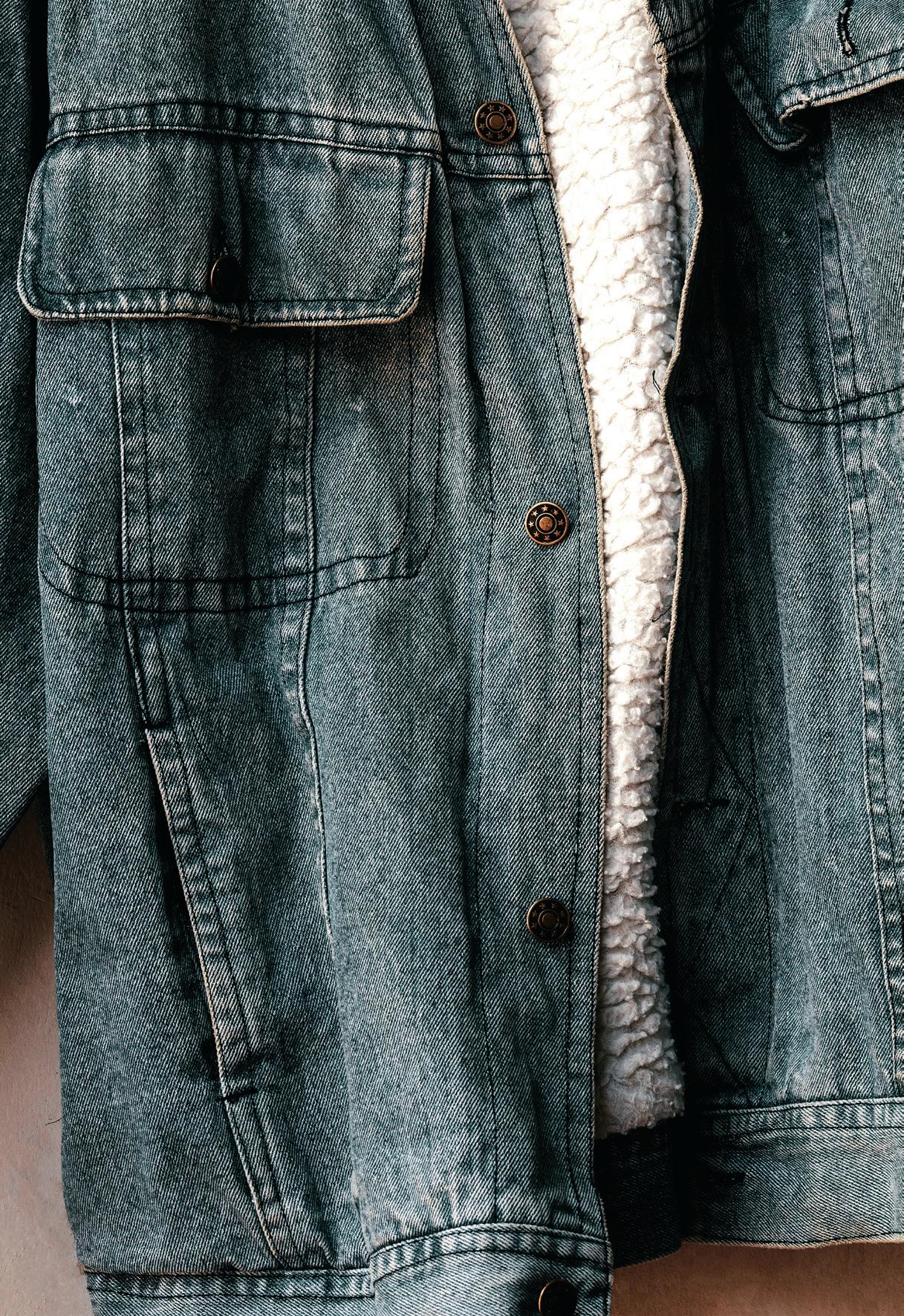
winter. Many produce garments tailored to our climate - light enough to layer but warm enough to wear on their own. Look for natural, breathable fabrics

like merino wool, cotton, and bamboo blends.
Sustainability is also becoming more important in fashion. Invest in timeless, well-made pieces that will last several seasons instead of fast fashion that falls apart quickly. Not only is this better for the environment, but it also makes good economic sense.

South African winters are brief but varied, which means your wardrobe should be built around flexibility, warmth, and comfort. Whether you’re bundling up for a Joburg frost or dodging rain in Cape Town, the key is layering, choosing quality materials, and finding the right balance between function and fashion. With a few essential items, you can build a winter wardrobe that keeps you warm, dry, and looking sharp all season long. LV

Why it’s even more important as we age
Sun damage is a concern at any age, but as we get older, our skin becomes especially vulnerable. Thinning skin and loss of elasticity allow the sun’s harmful UV rays to penetrate more deeply, damaging DNA and increasing the risk of premature aging and skin cancer. Sunscreen becomes absolutely essential for daily protection.
Winter can be just as tough on aging skin as the sun. Cold air, low humidity, and indoor heating can make your skin dry, dull, and more sensitive. As we get older, our skin makes less oil, which makes this dryness worse. This can lead to more fine lines and worsen conditions like sun damage or actinic keratosis.

Nia-Sol by Lamelle harnesses the power of nicotinamide
At Lamelle Pharmaceuticals, we’re proud to be known for our sciencebacked skincare, which is why we’ve relied on our expert knowledge of hardworking formulations and cutting-edge ingredients to create Nia-Sol.
The good news is that your skin can do well in every season with the right care. Changing your skincare routine to match your skin’s needs is part of aging.
Something else to keep an eye on? Hydration! Our skin gets drier and more sensitive over time due to a degrading barrier function. However, if you’re experiencing flat or slightly raised, scaly patches with a rough texture, you might be suffering from actinic keratosis (AK). These rough spots are the direct result of sun damage and, if left untreated, have the potential to develop into squamous cell carcinoma, a form of skin cancer.
Our nicotinamide-powered NiaSol range includes an all-natural oral supplement and two topical products. The supplement, Nia-Sol Capsules, contains nicotinamide along with a potent botanically derived antioxidant and anti-inflammatory vitamin D. These work synergistically to protect and improve the internal structure of the skin while repairing UV damage.

But don’t worry, it’s not all doom and gloom and there is something you can do about it.
Nicotinamide: A multitasking marvel
While sunscreen is your first line of defence, there’s another skin saviour for anyone prone to actinic keratosis and that’s nicotinamide. A form of vitamin B3 (also known as niacinamide), it’s an excellent antioxidant. It also soothes inflammation and strengthens your skin’s natural defences. Even better, studies have shown that taking nicotinamide orally can significantly reduce the risk of AK and certain skin cancers.
Nicotinamide applied directly to your skin is equally impressive. Research proves that regular use can significantly reduce the incidence of new actinic keratoses, particularly in those with a history of unprotected sun exposure and an increased risk of skin cancer.
Nia-Sol’s topical heroes – you can choose between a hydrating lotion or feather-light gel that’s ideal for spot-treating – both feature supersoothing, anti-inflammatory ingredients and DNArepairing Photolyase enzymes for targeted skin rejuvenation. Self-care is now as simple as taking a daily supplement and applying Nia-Sol Lotion or Gel!
If you’ve been affected by sun damage, have developed AK or are prone to them, Nia-Sol by Lamelle Pharmaceuticals is a great way to support your skin’s health, now and into the future. Paired with our next-level sunscreen, Helase 50+, you can look forward to healthier skin and the confidence that comes with knowing you’re getting the very best protection. Here’s to ageing gracefully, healthily and happily! For

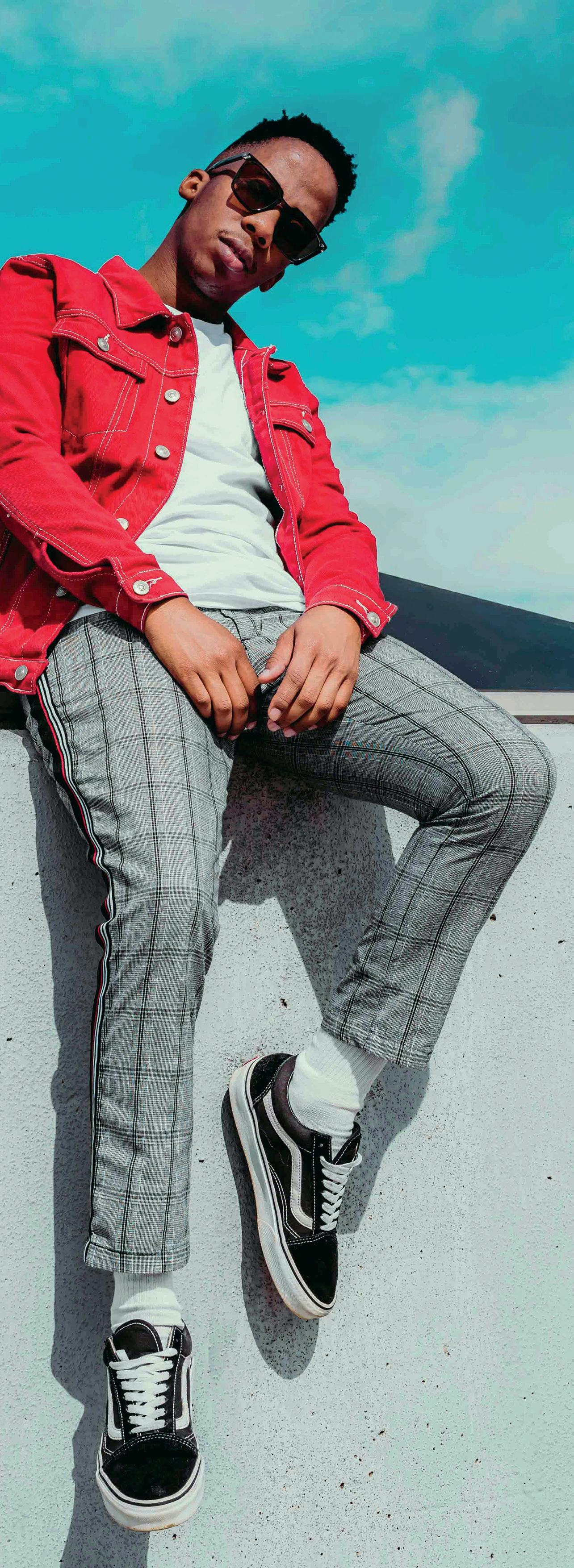
While the festive season in South Africa traditionally falls in the sunny warmth of December, there’s something equally magical about a mid-year winter holiday. Whether you’re escaping to a cosy mountain lodge, enjoying a city break, or hosting an intimate dinner at home, winter style in South Africa blends warmth with elegance, comfort with flair.
The key to mastering winter holiday dressing is layering - but done with style. Think textured knits, structured coats, and classic tailoring, all layered in a way that feels intentional and polished. Rich tones like burgundy, forest green, chocolate brown, and charcoal grey dominate the winter palette this year, giving outfits a refined, seasonal feel.
Women can embrace oversized knit dresses, belted for shape, paired with knee-high boots or sleek ankle booties. Throw on a tailored wool coat or a textured wrap, and you’re ready for a fireside dinner or city stroll.
Men can go for chunky knitwear layered over collared shirts, finished with a smart overcoat or quilted jacket. Dark denim or slim trousers keep the look clean and versatile.
Comfort doesn’t have to mean sacrificing style. For winter getaways or cabin weekends, soft cashmere sets, faux-fur accents, and teddy coats add a luxurious yet laid-back edge. Loungewear-inspired fashion is also trending - think elevated tracksuits in neutral tones, perfect for travel days or casual dinners with friends.
For a bit of winter sparkle, incorporate metallic accessories, a bold red lip, or statement earrings to dress up simple looks without going over the top.
Footwear & Accessories

Winter calls for boots - and this year, chunky soles, lace-up styles, and sleek knee-highs are all the rage. If you’re dressing up, classic leather ankle boots or heeled boots instantly elevate your outfit.
Accessorise with layered scarves, berets, or felt hats for a chic finish. A statement handbag or textured clutch adds a pop of interest to more neutral outfits.
Celebrate the Chill
From fireplaces and fine wine in the Winelands to alpine escapes in the Drakensberg, South Africa’s winter holidays call for fashion that’s warm, wearable, and still a little festive. The trick? Dress for the moment - and layer like a pro. Because winter style here isn’t just about staying warm - it’s about doing it beautifully. LV









For years, minimalism has reigned supreme, with its muted tones, clean lines, and decluttered spaces. Over the last year, the pendulum started to swing in the opposite direction, welcoming the bold, the vibrant, and the unapologetically expressive. Maximalism is taking centre stage, offering a fresh perspective on interior design that prioritises personality, texture, and layers of visual interest.


Cheryl Herweg from Changing Spaces Interior Design says, “Maximalism Design is not clutter but rather about curated abundance. It encourages the use of vibrant hues, luxurious textures, and diverse influences resulting in spaces feeling dynamic and personal.”
She says that some of the key elements of Maximalism Design include:
Bold colours and patterns
Embracing a rich vibrant colour palette and dynamic patterns, from florals to geometric designs, adding a layering of different motifs to create a sophisticated and expressive space.
Statement pieces and collec tibles
Maximalism thrives on storytelling. Mixing vintage and contemporary pieces, cultural influences, and artistic statements.
Layering and texture
Plush fabrics and textiles, ornate furniture, and a variety of materials add depth and warmth to the space.
Mixing styles with confidence
Unlike rigid design rules, Maximalism allows you to blend different styles seamlessly. Pair antique furniture with modern accents or combine global influences for a well-travelled aesthetic.
Floor-to-ceiling expression
From wallpapered ceilings to bold rugs, maximalism encourages the use of every surface. Statement lighting, gallery walls filled with artwork, dramatic drapery, and intricate mouldings further enhance the layered look.
Interiors that feature Maximalism Design are characterised by their fearless approach to design. Herweg says that a masterfully crafted maximalism space maintains a sense of cohesion through thoughtful curation and strategic layering.
“We have found that clients who appreciate history, culture, and storytelling through design, prefer a Maximalism Design in their homes,” says Herweg, “allowing them to separate from restrictive norms and embrace their tastes for us to create a visually captivating and immersive space for them.” She says that there is still a need for balance, the space is after all still being designed to come together in a stylish and prestigious way. This is done by incorporating a unifying colour scheme, ensuring a sense of flow between elements, and selecting statement pieces with intention.
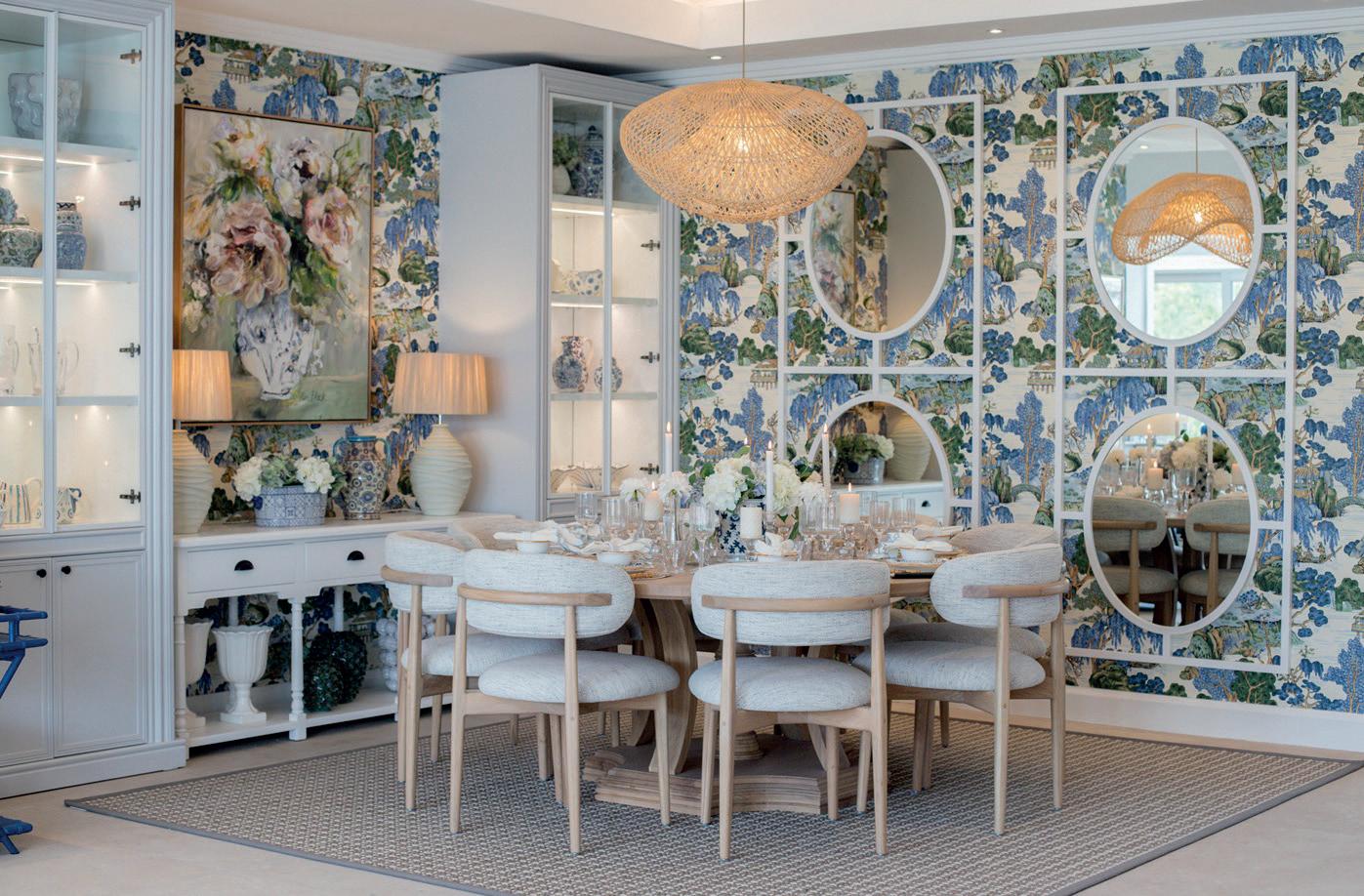
Herweg concludes, “Maximalism Design is more than just an aesthetic – it is a philosophy that encourages self-expression, creativity and the celebration of life’s richness.” As the design world continues to evolve, maximalism stands as a testament to the power of bold choices and uninhibited creativity. LV
Images from Changing Spaces Interior Design’s recently completed La Dique project in St Francis Bay, incorporating Maximalism Design.

As temperatures drop and the days grow shorter, it’s the perfect time to turn your home into a cosy haven. In South Africa, where winters vary from frosty Highveld mornings to wet Cape afternoons, winter home décor is all about creating warmth, comfort, and layered texture - without losing that relaxed, airy aesthetic we love.
Swap out summer brights for deeper, grounded hues that reflect the season. Think rust, olive, burnt orange, mustard, and rich browns - all of which add instant warmth to a space. These tones work beautifully on scatter cushions, throws, rugs, and accent walls. They pair perfectly with neutral base palettes, making it easy to refresh a room without a complete overhaul.
Winter is all about tactile comfort. Introduce layered textiles to your living spaces with chunky knit throws, velvet cushions, wool rugs, and fauxfur details. Mixing textures - from soft mohair to raw linen and leather - adds depth and a sense of cosiness.
Try draping a throw over a reading chair, layering multiple rugs underfoot, or adding a quilted bedspread in the bedroom for a luxurious, winter-ready look.
The right lighting can completely transform your home in winter. Soft, ambient lighting creates a welcoming and intimate atmosphere. Swap out cool-toned bulbs for warmer ones, and add candles, lanterns, or string lights for extra glow.
Table lamps with fabric shades, floor lamps with brass accents, or hanging pendants in natural materials like rattan
or clay will enhance the mood while complementing local design sensibilities.
Bring the Outdoors In Even in winter, South Africans are drawn to nature. Incorporate seasonal greenery - think eucalyptus branches, dried grasses, or muted-toned florals - to add life to your space. Natural wood finishes and handmade ceramics also echo the outdoor textures we crave during the colder months.
If you have a fireplace, make it the heart of your winter décor. Style the mantel with candles, art, or winter foliage, and arrange seating to encourage conversation and comfort around the hearth.
Whether you’re in a Cape cottage or a Johannesburg townhouse, winter décor is about creating a warm, lived-in feel that soothes the senses. With just a few thoughtful touches, you can turn your home into a space that welcomes the seasonand your guests - in style. LV


While South African winters may not be as extreme as those in the northern hemisphere, the dry air, chilly nights, and sudden cold snaps can still take a toll on your property - and your comfort. A few preventative steps can make all the difference in keeping your home cosy, energyefficient, and damage-free this season.
Whether you rely on a gas heater, fireplace, or electric panels, now’s the time to inspect and service your heating equipment. Clean filters, check vents for blockages, and ensure all units are functioning safely. Gas heaters, in particular, should be professionally inspected to prevent carbon monoxide leaks.

As winter settles over South Africa, it’s time to turn our attention to maintenance of our homes.
For homes with fireplaces, have chimneys cleaned and cleared of soot to avoid fire hazards and improve airflow. If you use wood or coal, stock up early to avoid mid-winter shortages.
Heat loss through windows, doors, and ceilings is one of the biggest causes of rising energy bills. Simple measures like sealing gaps with weather stripping, adding a door snake, or using thermal curtains can help retain warmth. If you haven’t insulated your roof yet, winter is a good time to consider it - proper insulation can reduce heating needs by up to 30%.
Winter rainstorms, particularly in the Western Cape, can expose weaknesses in your roof. Check for broken tiles, leaks, or sagging areas. Clean out gutters and downpipes to prevent blockages and overflow, which can cause water damage to walls and foundations.
In colder inland regions where frost is common, exposed pipes can freeze and burst. Wrap outdoor pipes and garden taps in insulating material. It’s also wise to disconnect and drain hoses and irrigation systems.
Rodents and insects often look for warm shelter during winter. Seal any gaps around the foundation, eaves, and garage. Regularly check attic and cupboard spaces for signs of unwanted visitors.
Don’t forget to test smoke and carbon monoxide detectorswinter is when we use heaters and fires the most, making these lifesaving devices especially critical.
A bit of preparation now can save money and prevent costly repairs later. With the right maintenance, your home will stay warm, efficient, and safe all winter long. LV
Replacing refrigerant with water between HBC and indoor units








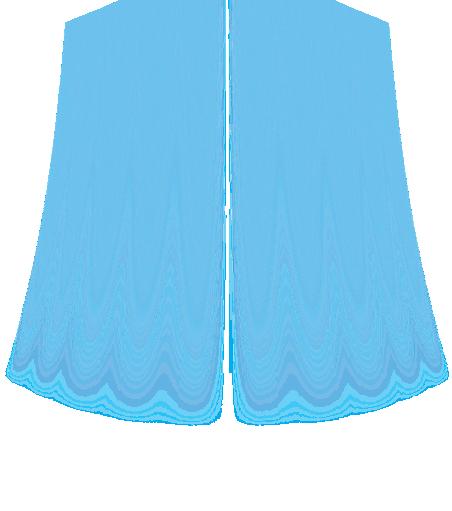










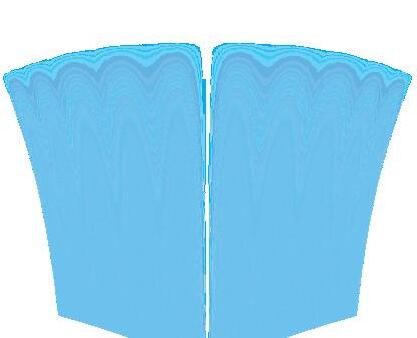



While winter in South Africa may not bring snowstorms and icy roads, the cooler months still invite a slower, more reflective pace of life. It’s the perfect time to step away from daily demands and invest in your wellbeing.
Across the country, a growing number of winter wellness retreats offer the ideal setting to relax, recharge, and reconnect - all while embracing the gentle chill of a South African winter.
From misty mountain lodges in the Drakensberg to tranquil eco-reserves in the Western Cape, South Africa’s diverse landscapes provide the perfect backdrop for a winter retreat. With fewer crowds and mild daytime temperatures, winter is an underrated season for travel especially when the goal is rest and rejuvenation.
Wellness retreats during this season focus on nurturing both body and mind. Morning yoga sessions under crisp blue skies, guided meditation in nature, and evenings spent by a fire with a cup of rooibos tea are all part of the experience. Many retreats offer massages, body treatments, and spa therapies using local botanicals known for their healing properties such as fynbos and African oils.
Saunas, steam rooms, and hot tubs are especially welcome in winter. In regions like Mpumalanga or the Cederberg, outdoor hydrotherapy becomes an invigorating experience, combining warmth and fresh air to soothe muscles and improve circulation. Some retreats also incorporate mindfulness practices such as journaling, forest bathing, or sound healing, designed to calm the nervous system and support emotional wellbeing.
Seasonal, nourishing meals are another highlight. Think slowcooked stews, roasted root vegetables, and warming herbal infusions often made with locally sourced, organic ingredients. Many retreats offer detox or plant-based options, designed to support digestion and boost immunity during the colder months.
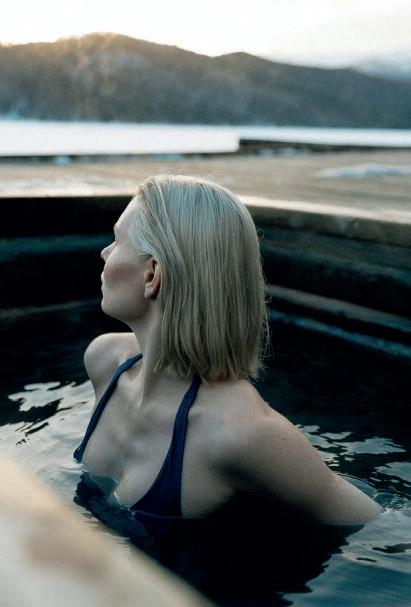
Whether you’re seeking silence and solitude or gentle group connection, South Africa offers a winter wellness experience to suit every preference. From rustic-luxury farm stays to boutique spa lodges and nature-based healing centres, these retreats provide a chance to slow down and restore. Ultimately, winter wellness retreats in South Africa are about aligning with the natural rhythm of the season. They offer a gentle reminder that rest is not just a luxury - it’s an essential part of living well. As the world quiets down, perhaps it’s time you did too. LV

Looking for a fun, highenergy way to stay active during the winter months?
Warm studio, cold season?
Ideal combination. F45 Training is the perfect indoor fitness solution.

By Wanita Wallace
When I was offered the opportunity to do a review on F45 Training, I literally jumped at it. I can remember thinking to myself that it would be a great way to get fit again and lose some weight I had gained over the years. So yes, why not? My first session was on a Friday. It’s crazy, isn’t it? As far as I know one is supposed to start something new on a Monday, but in any case…
I arrived for the 5am class at the Fourways club, and was greeted enthusiastically by Michaella, one of the F45 Training coaches. She asked if I had any injuries, she
should be aware of and showed me around before the session was about to begin. More members arrived, and everyone was upbeat and friendly.
Each F45 class is set up differently daily, and the main aim is to provide you with functional 45-minute sessions, delivered by experienced personal trainers, which improves overall cardiovascular fitness, and strength. The coaches explain each exercise and how many repetitions you need to do in each station, which ranges from 9 to 12, that you need to complete in 45 minutes. This includes warmup and cool down movements.

All exercises are displayed on screens in front of the studio combined with great music, and personal trainers are on hand to assist members where necessary.
Piece of cake, right?
Well… yes and no. F45 Training is for everyone, no matter your level of fitness or weight, but you do need to set a pace and rhythm for yourself and work hard, no matter how painful it feels. Ultimately, this is how you burn calories, because energy in equals energy out.
Almost 25 classes done so far, and I can feel a real difference. I have increased energy levels, have lost almost 10kg in two months and can even manage to do a burpee. But you need to be consistent. One thing coach Shaylin always says, is, “Make healthy choices today, and every day”.
Dare to try
There are trial classes available, so that you can get a feel for it, as well as various membership options to choose from. There are 7 sessions per day (Monday to Friday), two Saturday morning classes, with Hyrox training on a Sunday.
Once you have become a member you can download the F45 App and conveniently book whichever time slot suits you. It is also advisable to schedule an InBody test, which does a musclefat analysis of your body, as well as how much you weigh. This is great, because you get to keep track of your individual progress.
All you need to do is take a giant leap and make a booking at F45 Training – I can guarantee you will thank me!
For more information visit www.f45training.com LV






By Chris Jay
Winter in Bathurst, Eastern Cape, offers a delightful array of events that capture the town’s vibrant community spirit and historical charm of the village.
With an array of restaurants, pubs, shops, outdoor activities, and historical sites, Bathurst has something to delight every visitor. Over the years, the area has created a colourful and eccentric community of farmers, artists, academics, retirees, and semi-grants seeking a peaceful escape in the Eastern Cape of South Africa.


The area has a strong settler history. Founded in 1820, colonials left England in search of a more prosperous life in South Africa. They formed the village of Bathurst as a frontier town, naming it after Henry Bathurst, 3rd Earl Bathurst, Secretary for War and the Colonies. The town’s distinctly English feel remains as much of the original settler houses and other buildings have been preserved.
Besides all the outdoor activities like hiking, biking and game reserves, the sunshine coast has a lot more to offer, even during the cold winter months. Take a walk along the blue flag beaches, rent a boat and do some deep sea fishing, or take a slow booze cruise up the Kowie River.
Here are some upcoming standout festivities to look forward to:
Solstice Bagpiper – 21 June 2025
One of the highlights in Bathurst’s annual calendar, watch the lone bagpiper play into the evening at the Toposcope. Come and enjoy a Gluhwein or a traditional Old Brown Sherry.
Bathurst Dog Show – 20 July 2025
Held annually on the Village Green, the Bathurst Dog Show is a beloved community event celebrating our four-legged friends. This family-friendly gathering features a variety of entertaining competitions, including categories like “Friendliest”, “Noisiest”, “Hooligan”, and “Fancy Dress”. Attendees can enjoy live music, face painting, local stalls, and a joyful atmosphere that brings together dog lovers from all around.
Christmas in July – 25 to 27 July 2025
Experience the magic of the festive season during the South African winter at the Historic Pig and Whistle Inn’s “Christmas in July” celebration. The event features a traditional Christmas dinner with all the trimmings, a lively craft market offering unique handmade goods, live music performances, and festive activities for children. It’s a perfect opportunity to embrace the holiday spirit in a cozy, nostalgic setting.
Something worth mentioning and happening later this year and worth the visit, is the annual Bathurst Country Affair. Save the Date! Bathurst Country Affair is back from 29 to 31 August 2025! Expect delicious food, local wines, farm fun, and good old country hospitality.
Whether you’re a local resident or a visitor, Bathurst’s winter events provide warmth, entertainment, and a strong sense of community
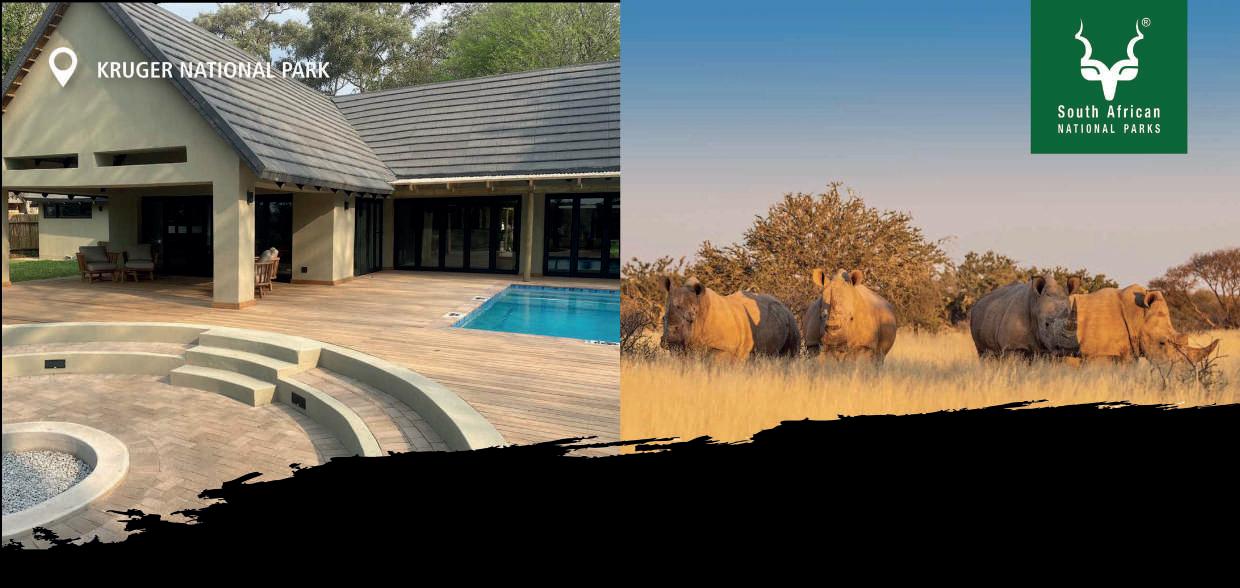

South Africa may be known for its sun-drenched summers and Big Five safaris, but winter brings a different kind of magic. From misty mountains to wind-swept coastlines, the colder months offer the perfect setting for heart-pumping adventure without the summer crowds. With crisp air, fewer bugs, and breathtaking scenery, winter is an ideal time to get outdoors and push your limits.
Whether you’re a seasoned adrenaline junkie or just looking for a unique way to experience the country, these winter-friendly adventure activities will warm your spirit - even when the temperatures drop.
Snow Sports in the Drakensberg & Eastern Cape
Yes, you can ski in South Africa - and winter is the only time to do it. The Southern Drakensberg and the highlands of the Eastern Cape sometimes receive enough snow for skiing, snowboarding, or snowshoeing. Resorts like Tiffindell (South Africa’s only official ski resort) offer equipment rental, lessons, and even snow fun zones for beginners.
Even when snowfall is light, the crisp alpine air, frozen streams, and snow-dusted peaks make for incredible winter hikes and scenic drives.
Whale Watching in Hermanus
From June to November, the coastal town of Hermanus becomes one of the best whale-watching spots in the world. Southern right whales migrate from Antarctic waters to calve and nurse their young in the warmer bays along the Western Cape coast.
Take to the sea with a guided whale-watching boat tour, or simply enjoy the show from the cliffs and coastal paths - where you might spot tails breaching just metres from shore. Kayaking with marine guides offers a quieter, more intimate encounter with these giants.

Hiking and Trail Running in the Cederberg & Cape Winelands
Winter is arguably the best time to explore South Africa’s iconic hiking trails. The Cederberg Mountains, just a few hours from Cape Town, come alive with dramatic skies, cooler temperatures, and waterfalls fed by winter rains.
The Jonkershoek, Mont Rochelle, and Greyton areas also offer excellent winter trail running and hiking, with fewer people and lush, misty terrain. Pack a thermos of coffee, good boots, and a windbreaker - and experience the Western Cape’s fynboscovered hills at their most beautiful.
Hot-Air Ballooning over the Magaliesberg
For something both thrilling and serene, a hot-air balloon flight over the Magaliesberg Mountains or Cradle of Humankind is pure winter magic. The crisp early morning air provides ideal flying conditions, with clear skies and minimal turbulence.
As you rise with the sun, you’ll enjoy panoramic views of golden plains, misty valleys, and game reserves waking up below. Most flights include a champagne breakfast - the perfect warm-up after an hour of unforgettable floating.
Sandboarding in the Atlantis Dunes or Sundays River
Who says winter can’t be about sand and speed? The Atlantis Dunes, just outside Cape Town, and the Sundays River dunes near Port Elizabeth offer massive, rolling sand hills ideal for sandboarding - a thrilling cross between snowboarding and surfing.
With cooler temperatures and firm sand, winter offers ideal conditions for full-day sessions. Boards are provided by local operators, who also offer quad biking and 4x4 dune tours for extra fun.
Caving in the Cradle of Humankind
Explore the ancient underground in the Sterkfontein Caves, part of the Cradle of Humankind World Heritage Site. These caves

stay a consistent cool temperature year-round - perfect for a winter day of discovery.
For something more rugged, wild caving experiences near Oudtshoorn or the Magoebaskloof region offer helmet-and-headlamp adventures that take you deep into narrow tunnels and chambers carved over millennia.
Surfing the Wild Coast
South Africa’s Wild Coast is untamed and remote - and in winter, its surf breaks come alive. Coffee Bay, Mdumbi, and Port St. Johns offer reliable winter swell, warm(ish) waters thanks to the Agulhas Current, and quiet beaches.
Pack your wetsuit and chase perfect left-hand breaks without the summer crowds. Not a surfer? These beaches also offer horseback rides, coastal hikes, and rural cultural experiences that feel wonderfully far removed from city life.
Bungee & Ziplining in the Garden Route
If you’re craving a true adrenaline fix, the Bloukrans Bridge Bungee Jump is a must. At 216 metres, it’s the world’s highest commercial bridge bungee - and it operates year-round.
Nearby, Tsitsikamma Canopy Tours and Storms River Adventures offer ziplining and kayaking through lush forest canopies and river gorges, made even more atmospheric in winter’s soft light and misty air.
Mountain Biking in the Karoo
The semi-arid Karoo region, too hot for summer adventure, becomes a cyclist’s dream in winter. Rugged trails, rolling hills, and endless skies make it the perfect place for off-the-grid mountain biking. The Tankwa Karoo, Prince Albert, and Carnarvon areas are especially popular with gravel bikers and endurance riders.
Several multi-day trail packages include stays at charming guesthouses with roaring fireplaces, home-cooked meals, and starlit skies.
From snowy slopes to golden savannahs, winter in South Africa offers some of the most rewarding - and often underrated - outdoor experiences the country has to offer. With the right gear and a sense of adventure, you’ll find fewer crowds, clearer skies, and an entirely new way to see the land.
So pack your jacket, charge your camera, and lean into the chill. Whether you’re chasing whales or waterfalls, zipping across treetops or trekking through mountain mist, winter is a season made for wild moments and unforgettable stories. LV
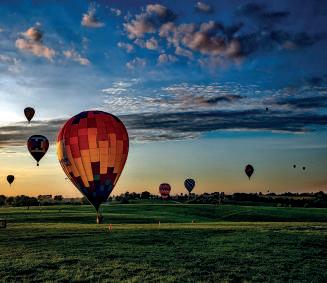
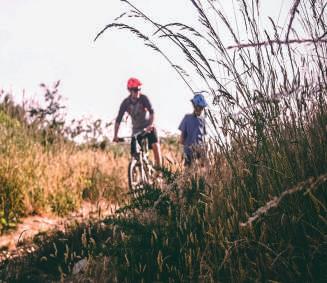
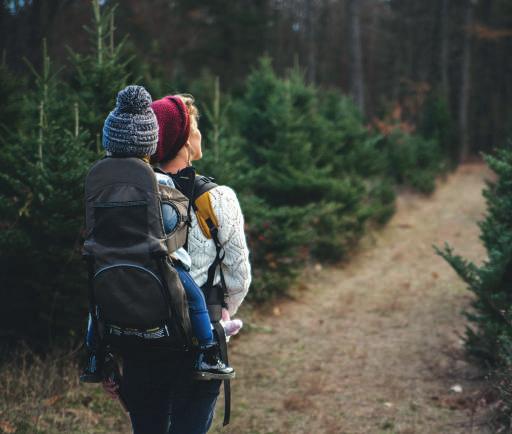

As the South African winter rolls in, bringing crisp mornings and early nightfall, our kitchens come alive with the scents of hearty dishes and simmering stews. Across the country, winter is a time of culinary nostalgia - when recipes passed down through generations find their way to our tables, and food becomes a source of both sustenance and soul-soothing comfort.
From potjiekos shared around open fires to a warm bowl of samp and beans or a bubbling malva pudding straight from the oven, South African winter comfort food is as diverse and deeply rooted as the cultures that make up the nation. It’s a celebration of tradition, community, and the undeniable joy of a hot meal on a cold day.
The Hearty Heart of the Home: Stews & Soups
No South African winter is complete without the unmistakable aroma of a slow-cooked stew. The potjie (pronounced “poi-key”), cooked outdoors in a cast-iron three-legged pot, is more than a dish - it’s an experience. Layered with meat, vegetables, and rich seasoning, potjiekos brings friends and family together, with the food cooking gently over hours of laughter and conversation. Variations include oxtail, lamb knuckle, or chicken with mushroom and white wine, each as satisfying as the last.
In the colder provinces, bean soup, or boontjiesop, is a staple, often made with sugar beans, ham hocks, or bacon. Thick, warming, and filling, it’s the kind of soup that sticks to your ribs and wards off even the deepest winter chill. Lentil soup, butternut with a hint of curry, or chicken and vegetable broths are equally popular, particularly when served with a hunk of crusty bread or roosterkoek - griddle-baked rolls with a smoky char.
Homegrown Classics: Pap, Samp, & Beans
Traditional starches like pap (maize porridge) and samp and beans (known locally as umngqusho) are cornerstones of winter comfort food. Pap, which can be served soft or stiff depending on preference, becomes a hearty meal when paired with tomato and onion relish or a thick meaty gravy. For many South Africans, it’s the taste of home.
Umngqusho, beloved in Xhosa and Zulu households, is a slow-cooked blend of samp (crushed corn) and sugar beans, often flavoured with butter, onions, and sometimes meat. It’s wholesome, protein-rich, and incredibly satisfying, particularly in colder months. Former president Nelson Mandela famously


cited it as one of his favourite meals, and it’s easy to see why: simple ingredients transformed by time and care.
Curry plays a significant role in South Africa’s winter cuisine, thanks to the influence of Indian and Cape Malay communities. A lamb curry, slow-cooked until tender and infused with spices like cinnamon, cardamom, and turmeric, is the perfect antidote to icy weather. Paired with rice and sambals or fresh roti, it offers both heat and
Cape Malay dishes like bobotie - a curried mince bake topped with a golden egg custard - offer a uniquely South African twist on winter fare. The sweet-savoury balance, with hints of apricot jam or raisins, makes bobotie a comforting favourite for many. Casseroles, meanwhile, offer no-nonsense nourishment. A chicken and mushroom bake or a cheesy mince-and-pasta dish are regular midweek staples in colder months, appreciated for both their warmth and their ability to feed a hungry household with minimal fuss.
No winter meal is complete without something sweet to finish, and South Africans excel in the art of indulgent puddings. At the top of the list is malva pudding - a spongy apricot-based cake soaked in a warm cream sauce. Served with custard or vanilla ice
Other winter favourites include melkkos, a milky, cinnamon-scented porridge often served with sugar and butter. Originally a Boerekos classic, melkkos is humble, nostalgic, and utterly comforting - best
For those with a penchant for baked goods, gingerbread, sticky toffee pudding, and baked sago with nutmeg and cinnamon offer a warming end
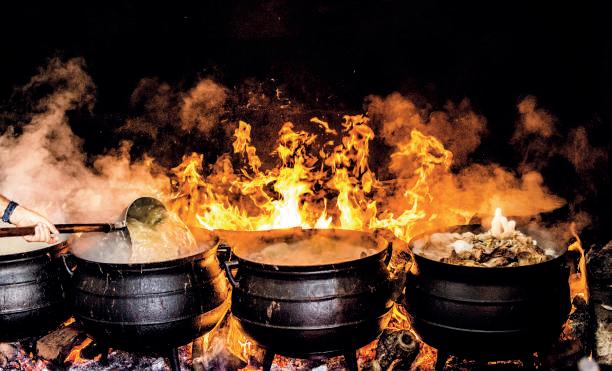
What makes South African winter food so special isn’t just the ingredients or the recipes - it’s the way they bring people together. Whether it’s a Sunday family lunch, a potjie shared with neighbours, or a solo bowl of soup after a long day, winter meals have a way of wrapping you up
They speak to our collective memories and shared history, honouring the rich tapestry of cultures that define South African cuisine. From the spiced stews of KwaZulu-Natal to the comforting roasts of the Karoo, every dish tells a story of resilience, togetherness, and joy. the chill settles in and the skies turn grey, South Africans turn to their kitchens - not just to feed their families, but to nourish their hearts. And in every simmering pot, every golden bake, and every of soup, there’s a little bit of home. LV

Winter braais are a different kind of magic. The pace slows down, the menu leans into comfort food, and the fire becomes more than just a cooking tool - it’s the heart of the gathering.
Why Braai in Winter?
In a country where sunshine graces most of the year, winter still offers plenty of clear, crisp days, particularly in the Highveld and coastal regions. Instead of sweltering heat, you get cool air, glowing embers, and the unmistakable scent of wood smoke drifting through the garden.
Braais are, at their core, about connection. They transcend seasons, politics, and backgrounds - whether you’re in Soweto, Stellenbosch, or Secunda. In winter, the braai becomes even more intimate. People huddle closer to the flames, conversations linger, and meals stretch into late afternoons or early evenings under warm blankets and woollen scarves.
A successful winter braai is all about creating warmth - physically and emotionally. Think fire pits or chimineas, lanterns or string lights, and plenty of throws and cushions. If you’re lucky enough to have a lapa or enclosed patio, it becomes the perfect braai headquarters. But even a simple backyard setup can do the trick with a bit of creativity.
Indoor-outdoor flow is key: you want the cooking to happen outside (as it should), but with a cosy area for guests to gather close by. Hot drinks and hand warmers? Bonus points.
What’s on the Menu?
While summer braais are all about light salads, boerewors rolls, and beers on ice, winter calls for heartier, warming dishes.
When the chill of winter settles over South Africa, and the morning mist lingers a little longer, one might assume that outdoor gatherings go into hibernation. But for South Africans, the braai - a beloved national pastime - is far from a fair-weather tradition. In fact, winter may be one of the most enjoyable times to light the fire, wrap up in a warm jacket, and gather around the coals with good food and even better company.
Meat & Mains
d Lamb chops: Fatty, flavourful, and fantastic on the grill. A rosemary and garlic rub gives them a winter twist.
d Marinated chicken thighs: Sticky and spicy peri-peri chicken remains a favourite in all seasons.
d Boerewors: Always a staple. In winter, try it in a boerie stew cooked in a potjie next to the fire.

d Beef short ribs or pork belly: Slow-grilled and basted in a sticky sauce - perfect for colder days.
Sides & Snacks
d Braai broodjies (toasted sandwiches with cheese, tomato, and onion) become golden and gooey on the fire.
d Grilled mielies (corn on the cob) with butter, salt, and a touch of chilli.
d Roasted sweet potatoes wrapped in foil and buried in the coals - sweet, smoky, and satisfying.
d Pap and chakalaka: A classic pairing that’s warm, spicy, and filling.
and fire.
In winter, these rituals become more poignant. There’s something elemental about standing together around the fire, breathing in wood smoke and catching up over a sizzling grill. It’s grounding. It reminds us that even when the world gets cold and quiet, community carries on.
Whether it’s a spontaneous Sunday lunch or a planned Youth Day celebration, the winter braai is a symbol of resilience, warmth, and South African hospitality.

Braaied bananas with chocolate and marshmallows wrapped in foil and grilled in the coals - a nostalgic crowd-pleaser.

Drinks to Warm the Soul Winter braais offer the perfect excuse to sip on drinks that heat you from the inside out:
d Mulled wine or glühwein, spiced with cloves, cinnamon, and citrus.
d Hot toddies made with rooibos tea, honey, lemon, and a splash of brandy or whisky.
d For the non-drinkers: spiced apple juice, hot chocolate, or chai rooibos lattes.
For many South Africans, the braai is more than just a meal - it’s a cultural anchor. It brings generations together: elders swapping stories near the flames, children playing nearby, and everyone sharing in the rituals of food
d Start early – Sunset comes quickly in winter, so get your fire going by midday.
d Layer up – Have blankets, jackets, and beanies on hand.
d Keep the fire going – Not just for cooking, but for warmth and ambiance.
d Prep in advance – Marinate your meat the night before, and have sides ready to go.
d Think comfort – Whether it’s seating or the food, the goal is to make people feel at home.
A South African winter braai is a celebration of contrasts: the cold air against a hot grill, the quiet of the season interrupted by laughter and storytelling, the stillness of a Sunday afternoon made lively by sizzling meat and warm hands wrapped around a mug of something comforting.
In a world where seasons change but the need for connection remains constant, few things say “you’re welcome here” quite like a fire, a flame, and a feast shared under winter skies. So don’t pack away the tongs just yet - winter is braai season, too. LV

As South Africa transitions into the cooler months, there’s a distinct change in the rhythm of life. The pace slows, fireplaces roar back to life, and our palates shift from crisp summer whites and spritzes to heartier, more robust fare. It’s the perfect time to rediscover the country’s exceptional winter wines and spirits - beverages that warm from the inside out and complement everything from rich stews to cozy nights under blankets.
When it comes to winter wine, nothing beats a full-bodied red to take the edge off a frosty evening. South Africa’s winelands produce some of the finest red wines in the world, and winter is their time to shine. Varietals like Shiraz, Cabernet Sauvignon, Merlot, and Pinotage lead the charge, offering depth, spice, and warmth. Shiraz, particularly from regions like Swartland and Stellenbosch, is a winter staple. Known for its peppery notes, dark fruit flavours and smoky undertones, it’s ideal with game meats, venison pie or grilled lamb chops. Top producers like Mullineux, Rust en Vrede, and Tokara craft versions that are both elegant and powerful. Cabernet Sauvignon thrives in cooler climates and matures beautifully in oak,
offering complexity and age-worthiness. Look out for bold examples from Constantia, Paarl and Stellenbosch - the triad of classic Cabernet terroirs. These wines exhibit notes of cassis, cedar, tobacco, and firm tannins - perfect with oxtail stew or a rich beef bourguignon.
No conversation about South African reds is complete without mentioning Pinotage. A proudly local cultivar, this cross between Pinot Noir and Cinsaut often polarises opinion but shines in winter. Modern Pinotage styles are supple and smoky, with notes of plum, coffee, and spice - brilliant with slow-roasted pork belly or a traditional bobotie.
South Africa also produces a fine array of fortified wines - an often-overlooked category that fits winter like a glove. Producers in Calitzdorp (known as the “Port Capital of South Africa”) continue to create exceptional Cape-style “Ports” from Touriga Nacional, Tinta Barocca and Souzao grapes.
A glass of Cape Vintage Reserve after dinner is pure luxury, rich in flavours of dried fruit, spice, and dark chocolate. Serve it with a cheeseboard or dark chocolate dessert,
and you’ve got a fireside pairing made in heaven.
Equally compelling are sherry-style wines, made using oxidative winemaking methods. These amber-hued sippers, such as Monis Medium Cream or KWV’s range, offer toffee, almond and dried apricot notes - perfect as an aperitif or with baked winter puddings.
While red wines dominate winter tables, don’t overlook the whites. Aged or barrel-fermented whites can offer body, complexity and warmth that rival lighter reds. Chenin Blanc and Chardonnay are the top contenders.
Barrel-aged Chenin Blanc - a South African speciality - reveals layers of baked apple, honeycomb and spice. Producers like Raats Family Wines and Alheit Vineyards showcase how versatile this grape can be. These wines pair beautifully with creamy chicken dishes or mushroom risotto.
For those who favour a classic Chardonnay, look to the cooler regions of Elgin and Hemel-en-Aarde, where citrusy acidity is balanced by creamy oak notes. Enjoy it with roast chicken, butternut ravioli or smoked salmon pasta for a winterfriendly twist on white wine.

When the mercury drops, spirits take centre stage. Whether sipped neat or mixed into warming cocktails, South African gins, whiskies and brandies offer depth and character perfect for the season.
South African brandy has long held a place in the country’s drinking culture, and for good reason. Brands like KWV, Van Ryn’s and Oude Meester have taken home international accolades. XO and 15-year-old versions are beautifully smooth and complex, offering caramel, spice, and fruitcake notesperfect for sipping by the fire or as a base in a Hot Toddy.


Local whisky has also gained serious traction, with Three Ships and Bain’s Cape Mountain Whisky leading the charge. Bain’s, a single grain whisky made from maize, is rich and mellow with hints of banana, toffee and spice. It’s a great sipper, or you can enjoy it in a warm whisky cocktail like a Winter Old Fashioned or a classic Hot Buttered Whisky.
Gin, though usually associated
with summer, has found a place in winter through creative infusions and warming serves. Local gins made with indigenous botanicals like rooibos, buchu and wild fennel pair well with winter mixers like blood orange tonic or warm cider. Try Inverroche Amber or Sugarbird Fynbos Gin in a spicy Negroni twist or with a splash of warm ginger ale and a cinnamon stick.
The art of winter wine and spirit enjoyment is often in the pairing. Think of flavours that echo the season: spice, smoke, earth, and richness. Hearty roasts, root vegetables, game meat and stews all call for bolder wines and nuanced spirits. And don’t shy away from a little indulgence - a glass of dessert wine with sticky toffee pudding or malva pudding can be the exclamation mark at the end of a perfect winter meal.
From the vineyards of the Western Cape to the distilleries nestled in the countryside, South Africa offers a world of warming beverages to suit every winter mood. Whether you’re toasting marshmallows, hosting a dinner party, or simply curling up with a good book, there’s a bottleor glass - that can make winter all the more enjoyable. So, pour something special, raise a glass, and celebrate the flavours of the season. LV

The BYD Shark is not just another bakkie - it’s the first plug-in hybrid of its kind in South Africa. With cutting-edge tech, thrilling performance, and genuine practicality, this bold Chinese newcomer is here to ruffle feathers in a market long ruled by diesel. Wanita Wallace took it for a test drive.
Beneath the bonnet, the Shark hides some serious firepower. It combines a 1.5-litre turbocharged petrol engine with dual electric motors, one for each axle, producing a combined 321 kW and 650 Nm. That means this bakkie can sprint from 0 - 100 km/h in just 5.7 seconds.
That’s not a typo - this double cab is quicker than most hot hatches, and faster than anything else in its class.
Better still, it offers up to 100 km of pure electric range (NEDC), meaning many commuters can do their daily driving without using any fuel at all. Add the hybrid range extender, and you’re looking at a total range of over 800 km.
Visually, the Shark is modern, muscular, and futuristic without looking too flashy. The front grille and LED signature lighting give it real presence, while the sharp body lines and big wheels complete the confident look.
Climb inside, and you’re greeted by a cabin that feels more SUV than workhorse. The top-spec model features synthetic leather upholstery, a huge rotating touchscreen (up to 15.6 inches), a fully digital instrument panel, and a 12-speaker Dynaudio sound system.
Everything feels slick and user-friendly, and BYD’s software is quick and intuitive. There’s no guesswork here - it’s a system built for the digital age.

While it may be high-tech and high-powered, the Shark doesn’t forget its roots. It offers a payload of 835 kg and a braked towing capacity of 2,500 kg. That’s slightly behind some rivals, but still practical enough for most small business owners and outdoor adventurers.
The 1,450-litre load bin is useful, and the Shark adds something extra - bidirectional charging. You can plug in tools, camping fridges or even a kettle and run them straight from the vehicle’s battery. Perfect for weekend escapes or remote site work.
In day-to-day driving, the Shark feels composed and quick. It’s easy to manoeuvre in traffic, and the instant torque from the electric motors makes it feel light on its feet. Ride quality is on the firm side, especially at the rear when unladen, but it’s never uncomfortable.
Off-road, the Shark offers drive modes for sand, snow and mud, with decent ground clearance and good grip. That said, it’s not a hardcore trail machine - it’s more lifestyle bakkie than rock-crawler. Think game farms, gravel roads, and the occasional muddy track.




Engine: 1.5-litre turbo petrol + dual electric motors
Power: 321kW
Torque: 650Nm
0–100 km/h: 5.7 sec
EV range: ±80 km (NEDC)
Combined range: ±840 km
Payload: 835 kg
Towing capacity: 2,500 kg
Drive: Electric AWD
Price: R959,900
The BYD Shark is a new kind of bakkie - cleaner, smarter, and sharper. It won’t be for every farmer or fleet buyer, but it’s perfect for those ready to embrace the future.
Whether you call it brave, bold, or just bonkers, one thing’s for sure: this is the bakkie disruptor South Africa didn’t see coming. LV
Sustainable Future – Drive with zero emissions and join the movement toward a cleaner planet.


Step into the future with BYD, the global leader in electric mobility. Our cuttingedge vehicles combine advanced technology, exceptional range, and eco-friendly performance, giving you a smarter, greener, and more exciting drive.
Power & Efficiency –
Enjoy smooth acceleration, extended range, and ultra-fast charging for a hasslefree driving experience.
Join the revolution.
Drive BYD.
Find your perfect EV today!


Unrivalled Battery Technology –Powered by the revolutionary Blade Battery, BYD vehicles offer superior safety, longevity, and efficiency.

Sleek & Smart Design – Whether it’s the stylish BYD Seal or the dynamic Atto 3, there’s a perfect BYD for every lifestyle.


In the heart of Rwanda’s misty highlands lies one of the world’s most profound wildlife experiences - gorilla trekking. At the forefront of this rare adventure is Singita, a name synonymous with conservation, luxury, and transformational travel. Through its Kwitonda Lodge, Singita offers an intimate and deeply respectful encounter with endangered mountain gorillas, all while wrapped in the comforts of exceptional hospitality.
A Sanctuary on the Edge of the Wild Singita Kwitonda Lodge is located on the edge of Volcanoes National Park, where the lush rainforest carpets the dramatic slopes of dormant volcanoes. This setting is not merely scenic - it is strategic. The lodge sits on 178 acres of private land that directly borders the national park, creating a buffer between cultivated lands and pristine habitat. Here, nature and architecture harmonise: the lodge is crafted using local stone, wood, and earth tones that echo its surroundings,
and every detail is imbued with purpose. Sustainability is woven into the very fabric of the buildings, which feature solar power, rainwater harvesting, and organic gardens.
From each suite, guests enjoy panoramic views of the volcanic peaks and the enveloping forest. Private heated plunge pools, fireplaces, and oversized windows create a cozy atmosphere that remains tethered to the wilderness. But what truly sets this place apart is what lies just beyond the lodge’s border: access to some of the last remaining mountain gorillas on earth.
Trek Begins
The day of the trek begins early, often before the sun has pierced the morning mist. After a warm cup of Rwandan coffee and a light breakfast, guests depart for the Volcanoes National Park
headquarters, just minutes from the lodge. Here, park rangers give a detailed briefing on what to expect, how to behave in the forest, and the importance of the trek in preserving these majestic animals.
Each trekking group is limited in size, and guests are assigned to specific gorilla families based on physical fitness, interest, and recent sightings. The treks vary in difficulty - some gorilla groups may be reached within an hour, while others require several hours of uphill hiking through thick vegetation, muddy trails, and fluctuating altitude. But the reward at the end of the trail is beyond compare.
There are few experiences in life as humbling as looking into the eyes of a wild mountain gorilla. In near silence,


visitors are permitted to spend up to one hour in the company of a habituated gorilla family. Silverbacks, with their immense bulk and calm authority, oversee family groups that include females, adolescents, and infants clinging to their mothers’ backs or tumbling through the undergrowth in play.
The experience is raw and emotive. There is no fence, no barrier - only an unspoken pact of mutual respect.
The guides, many of whom have dedicated their lives to gorilla conservation, ensure that strict protocols are followed: visitors wear masks, maintain a safe distance,
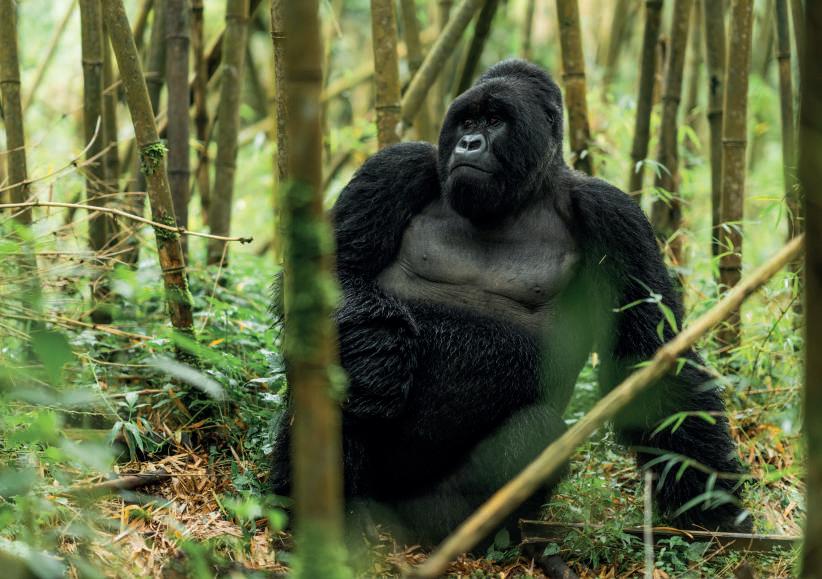
and observe without intruding. Each trek is unique. Some are peaceful and stationary, with gorillas lounging in the underbrush. Others are dynamic and fast-moving, with the family on the go. Regardless of the encounter, trekkers emerge changed - deeply moved by the intelligence, gentleness, and vulnerability of the gorillas.
After the physical exertion and emotional high of the trek, Singita Kwitonda welcomes guests back with open arms. Muddy boots are whisked away. A hearty lunch awaits, often featuring ingredients grown in the lodge’s own garden. Guests can choose to relax in their suites, enjoy a spa treatment, or recount their adventures over Rwandan tea or a glass of wine by the fire. Every detail at the lodge serves to elevate the sense of reflection and connection. Guests are encouraged to engage with conservation education, learn about Rwanda’s post-genocide
recovery, and interact with the nearby community through guided village visits. The experience extends beyond wildlife - it is about culture, history, and the future of Rwanda.
What makes the Singita experience truly meaningful is its commitment to conservation. Singita doesn’t just offer gorilla trekking - it actively supports the preservation of the very species it helps visitors see. Through reforestation initiatives, the planting of hundreds of thousands of native trees, and partnerships with local organisations, the lodge plays a vital role in restoring degraded land and providing a critical buffer zone for the national park. Equally important is the investment in local communities. Singita employs residents from surrounding villages, sources materials and produce locally, and supports education and livelihood
programmes. Guests become part of this story - not just observers, but contributors to a larger mission of sustainability and empowerment.
Gorilla trekking is a seasonal activity, best undertaken during the dry months from June to September and again from December to February. The experience is tightly regulated to ensure the health and well-being of the gorillas, with daily permits limited and issued in advance. Trekking can be physically demanding, and altitude can be a factor, so a moderate level of fitness is recommended.
However, Singita makes the journey accessible and enriching for all kinds of travellers. Whether you are a seasoned adventurer or a first-time safari-goer, the lodge provides everything you need to feel prepared and cared for - from personalised packing advice to warm,
knowledgeable guides who walk with you every step of the way.
A stay at Singita Kwitonda Lodge is more than a luxury escape - it is a pilgrimage to one of the last wild frontiers, a chance to come faceto-face with nature’s quiet strength and resilience. It’s an opportunity to disconnect from the digital world and reconnect with something ancient and elemental.
Gorilla trekking is not a passive activity. It demands something of the traveller - patience, humility, and reverence. In return, it offers a gift so rare and transformative that it lingers long after the trek ends. With Singita as your guide, the journey becomes not just a trip, but a life-altering experience woven into the fabric of Rwanda’s breathtaking beauty and enduring spirit. LV


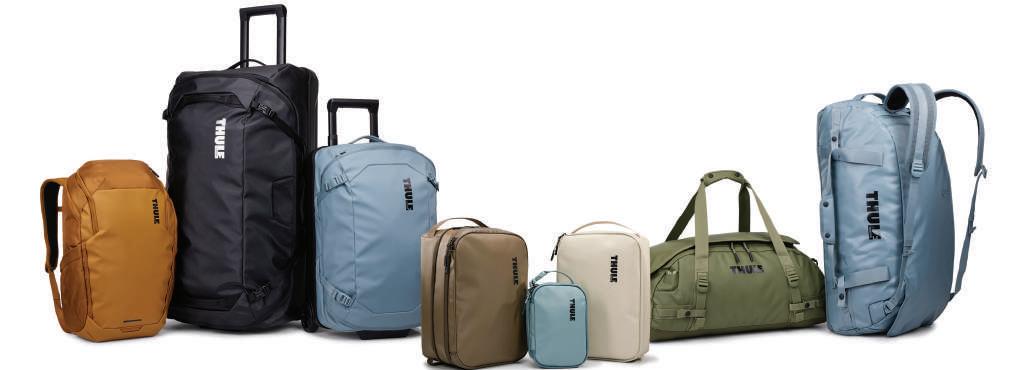

South Africa’s residential landscape is a rich tapestry woven from cultural diversity, breathtaking geography, and a deep appreciation for lifestyle. Across the country - from Cape Dutch farmhouses nestled in the winelands to contemporary masterpieces overlooking the Indian Ocean - South African homes are a unique blend of elegance, innovation and authenticity.
More than just spaces to live in, the most inspiring homes in South Africa reflect a philosophy of design that embraces nature, heritage and a deep connection to place. They are sanctuaries of beauty, offering not just shelter but a way of life that balances modern luxury with soulful living.
A Country of Contrasts, A Canvas for Creativity
South Africa’s unique topography and climate zones give rise to an architectural language that is as diverse as its people. Here, homeowners and architects have the opportunity to design for mountains, coastlines, savannahs, and cities -
often in one singular project.
The diversity in landscape has inspired architecture that is deeply responsive to its environment. In the Cape Winelands, homes often pay homage to traditional Cape Dutch architecture, with symmetrical gables, thick whitewashed walls and thatched roofs. In contrast, homes in Johannesburg and Pretoria explore a more contemporary vernacularembracing glass, concrete, steel and open-plan interiors that reflect the pulse of modern urban life.
Coastal homes, particularly along the Garden Route, the Atlantic Seaboard, and KwaZulu-Natal’s North Coast, lean into the indoor-outdoor lifestyle, making use of decks, verandas and
courtyards that open out to panoramic views of the sea or indigenous forest. These homes are light-filled and breezy, with large windows, organic materials and a palette inspired by sand, sea and sky.
The new wave of elegant South African homes is not just about architectural brilliance; it is also about conscious design - celebrating African materials, craftsmanship and storytelling. Increasingly, local artisans and designers are being featured alongside international design icons in the creation of interiors that are both sophisticated and grounded.
In Johannesburg’s affluent suburbs


like Hyde Park, Houghton and Westcliff, we see the rise of homes that blend cosmopolitan flair with African luxury. Polished concrete floors sit beside wooden sculptures; bold artworks from local artists add colour to minimalist interiors; and furnishings often feature handcrafted elements - from woven grass to carved timber.
Cape Town, with its design-forward culture and proximity to nature, leads the way in sustainable luxury. Think solar-powered homes with rainwater harvesting, rooftop gardens, and repurposed materials that give old structures new life. These are homes that embody mindful living while still delivering on aesthetics and comfort.
1. Silver Bay Villa, Western Cape Located near Gansbaai, this sleek coastal home is a triumph of modern design. Created by SAOTA architects, Silver Bay Villa combines dramatic
glass walls with natural stone, offering uninterrupted ocean views while harmonising with its rocky surroundings. Inside, the interiors are understated but luxurious - floating staircases, timber ceilings and a seamless connection to outdoor entertainment spaces make this an exemplar of coastal chic.
Designed by Nico van der Meulen Architects, House Boz is a futuristic yet welcoming home that plays with geometry, steel, and glass. The openplan design and expansive glazing give it an ethereal quality, while the use of earthy tones and water features brings it back to a serene African context. It’s a bold, sculptural statement that proves elegance can be daring.
For those who favour timeless elegance, Leeu Estates - part private villa, part luxury hotel - offers an incredible model of heritage-inspired living. The interiors feature curated South African and international artworks, custom-designed furniture, and materials such as marble, French oak, and handmade ceramics. Nestled
among vineyards and mountains, this estate is a true reflection of Cape refinement.
Another showstopper by Nico van der Meulen Architects, the Kloof Road House is all steel, glass and open volumes. Designed for entertaining and family living, it showcases how raw materials like concrete and steel can be made warm and elegant when paired with lush gardens, clever lighting, and inviting textures.
In many elegant South African homes, the use of natural, tactile materials is central to the experience. Think exposed beams, sandstone cladding, terracotta tiles, and handwoven textiles. These materials don’t just elevate the look of a space - they create an emotional connection to the landscape and a sense of rootedness. Local stone, reclaimed wood, and clay bricks are popular not only for their beauty but for their sustainability and low environmental impact. There’s also a strong return to locally sourced artisanal decor: handblown glass from
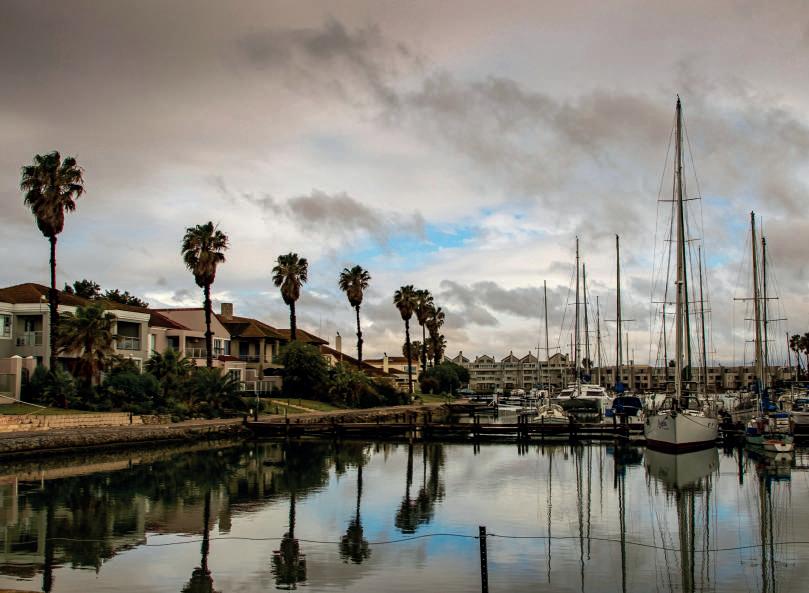



Cape Town, Nguni hides from the Free State, ceramics from Limpopo, and woven baskets from KwaZulu-Natal.
These elements bring character and authenticity into spaces that could otherwise feel overly polished. In many ways, this emphasis on craft and narrative is what distinguishes South African elegance from generic luxury - it is luxury with soul.
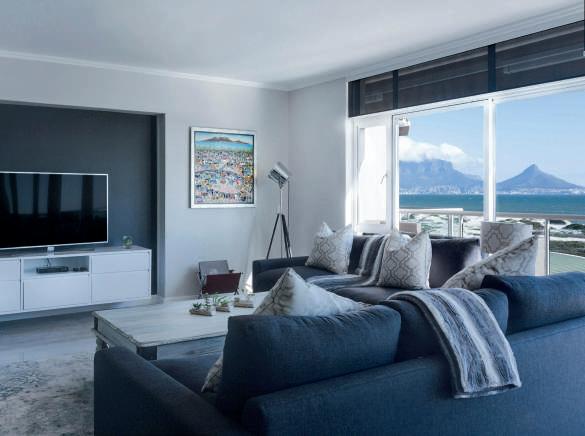
One of the defining features of elegant South African homes is the seamless transition between indoors and out. Thanks to the country’s temperate climate and scenic diversity, designers often blur the lines between architecture and landscape.
Large glass sliding doors, wraparound patios, pergolas, and open-air showers allow nature to be part of daily life. Braai areas and fire pits are more than entertainment zones - they are modern-day hearths around which life is shared.
Courtyards and atriums - especially in urban settings - provide a sanctuary of green and light within built-up spaces. Indigenous planting, water features, and vertical gardens are now essential in creating homes that feel alive and restorative.

The modern South African home embraces smart technology without sacrificing warmth. Automated lighting, security, irrigation, and energy systems are increasingly standard in luxury homesallowing for control, convenience and sustainability.
In high-end properties, you’ll find intelligent systems that regulate temperature, light, sound and even scent. Yet, the true
elegance lies in their discreet integration - tech that enhances comfort but never overshadows the architecture.
This is particularly relevant in South Africa, where concerns around power outages and water scarcity have made off-grid living not just a trend but a necessity. Elegant homes now incorporate battery storage, greywater systems, and passive cooling as part of their design DNA.
What makes South African homes truly inspiring is the freedom of expression they afford. This is a country where you can find an Italian-inspired villa in Camps Bay, a minimalist glass box in Sandton, a French farmhouse in the Midlands, and a tribal-modern retreat in Mpumalanga - all existing with equal authenticity.
This cultural mosaic is reflected in interiors too. You might find Zulu beadwork framed alongside contemporary photography, or Persian rugs layered over concrete floors. Designers are increasingly collaborating across cultures, bringing together traditional artisans and contemporary visionaries to create homes that are both global and deeply local.
Beyond the architecture and design, what sets elegant South African homes apart is their emotional resonance. These are not homes built to impress - they are built to live in, to gather in, to dream in. They are backdrops to the rituals of daily life, designed with care, craftsmanship and consciousness.
In many of these homes, you feel the influence of Ubuntu - the African philosophy that places emphasis on shared humanity. There’s an openness, a generosity of space and spirit. Homes are designed not just for the individual, but for family, for friends, and for connection.
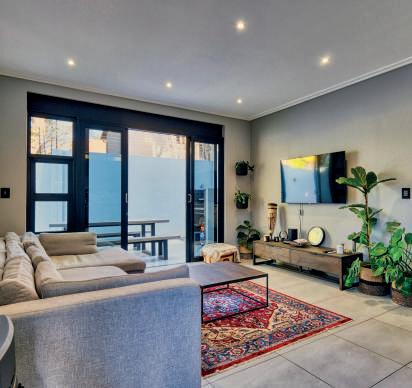
In a world where design often chases trends and spectacle, South African homes remind us of the power of place, history and heart. They show that elegance is not just about perfection, but about presence - the ability of a space to hold meaning, beauty and memory.
Whether it’s a modern glass house overlooking the ocean, a restored Karoo farmhouse, or a leafy urban retreat in Johannesburg, the most inspiring homes in South Africa share a common thread: they reflect the lives and values of those who inhabit them. They are elegant not because they are expensive or extravagant, but because they are deeply considered and beautifully lived in.
As the world looks increasingly to design solutions that are sustainable, meaningful and grounded, South Africa stands as a shining example. It is a place where luxury is redefined not by opulence, but by soul - and where the most elegant homes are those that speak to the land, honour the past, and embrace the future.

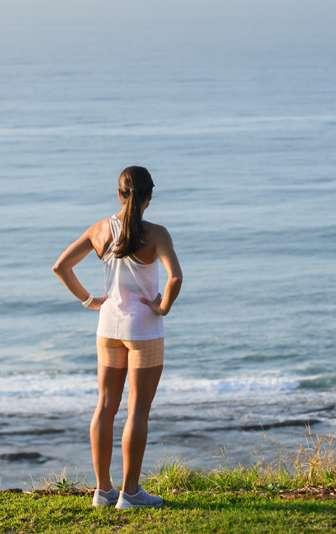





Seaton Estate offers an exclusive opportunity to secure land, luxury coastal condos, or a Planned Unit Development (PUD) site within one of the most sought-after estates on the North Coast. With direct beach access, world-class amenities, and breathtaking views.
Seaton’s final land release offers a rare opportunity to secure prime coastal property. Precinct J (R1.159 million) with an ERF size of 1044 m² andlocated near the main gatehouse and equestrian clubhouse, Precinct A (from R3.35 million – R15.5 million) presents front-row sea view sites just steps from direct beach access. Precinct E (from R1.45 million) is surrounded by forest pathways and overlooks the conservation valley, with bridle paths weaving through. Precinct F (from R2.4 million) is near the main clubhouse and sports centre, featuring tennis courts, swimming pools, padel, basketball, and a restaurant.
COASTAL CONDOS
A limited collection of luxury 3 and 4-bedroom coastal condos starting from R3.69 million. These spacious 3-bedroom residences feature modern interiors, wrap-around balconies, and panoramic views of Christmas Bay. Designed for effortless coastal living, each condo provides direct access to all of Seaton’s world-class amenities.
Planned Unit Developments at Seaton offer a rare opportunity for developers, combining modern living with prime coastal positioning. These future-ready sites provide a versatile, high-value residential option within one of the North Coast’s most sought-after estates.
With limited availability, this final release offers you the chance to secure a home in this prestigious coastal community and experience a lifestyle that is hard to beat anywhere in the country. Access Seaton’s Beach Club, equestrian facilities and Zululami facilities.

Where Korean BBQ meets Chinese hot pot and South African soul - all at one unforgettable table.
Tucked discreetly above the bustling Rivonia Boulevard in Sandton, Biru Restaurant is one of Johannesburg’s most engaging culinary experiences - a rare place where the sizzling theatrics of Korean BBQ, the comfort of Chinese hot pot, and the warmth of South African braai culture all come together around a single table.
With its unique combination of Asian and African traditions, Biru is more than a restaurant - it’s a destination. And in a city known for culinary diversity, it still manages to offer something refreshingly original.
The first impression of Biru is understated. Located on the third floor of a nondescript building in Rivonia, it doesn’t scream “high-end dining”.
But step inside and you’re greeted by a stylish, open-plan space that’s been carefully curated to balance elegance with interactivity.
Each table is fitted with built-in grills or induction burners, inviting you to roll up your sleeves and become part of the cooking process. With sleek wooden finishes, warm lighting, and wide windows that catch the afternoon sun, the ambience is both contemporary and inviting - perfect for a relaxed lunch or a lively evening out.
The Concept: Cook, Connect, Celebrate
Biru’s signature offering is its “interactive dining” experience - a hands-on, social way to eat that feels equal parts nourishing and entertaining. Diners choose from three primary formats: Korean-style

BBQ, Chinese-style hot pot, or a combination of both.
Whether you’re searing premium Wagyu beef over a charcoal flame or simmering fresh tofu and bok choy in a bubbling broth, you’re in control. It’s the kind of meal that makes conversation effortless and time disappear.


This concept isn’t new in global terms, but in Johannesburg - and especially in Sandton - it remains a novelty. And Biru executes it with flair.
Flavour on Your Terms
We opted for the hybrid experience, combining Korean BBQ with a divided hot pot - one side mild and herby, the other rich and spicy. Both broths arrived steaming, their aromas mingling with the first hints of meat meeting flame.
On the grill: slivers of marbled Wagyu, tender pork belly, and
juicy prawns. Everything arrived beautifully presented and expertly portioned for sharing. The meat quality was outstanding, and the grill’s adjustable flame allowed for precise cooking - or gentle charring, depending on your preference.
In the pot: a generous selection of vegetables, tofu, handmade fish balls, mushrooms, lotus root slices, and glass noodles. We loved how the broths evolved in flavour as we added ingredients - an ever-changing, deeply satisfying experience.
A selection of dipping sauces,
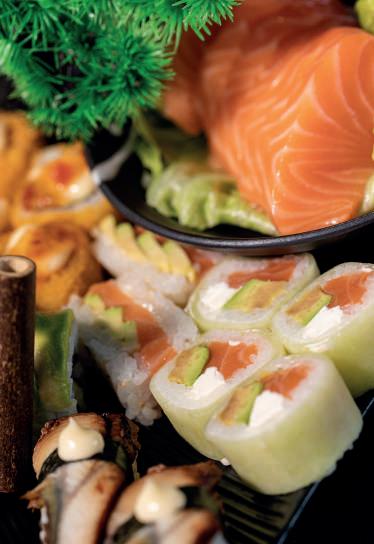
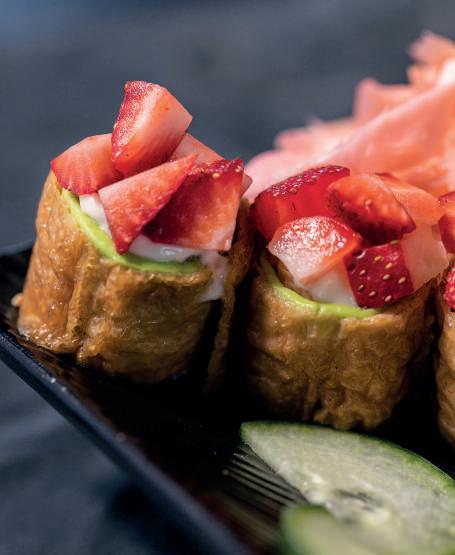

including sesame, soy-garlic, and spicy chilli oil, encouraged experimentation. We built each bite like a work of art: dipped, wrapped in lettuce, and devoured with satisfying crunch and sizzle.
What sets Biru apart from similar restaurants in Cape Town or overseas is its subtle nod to South African braai culture. The sense of cooking and sharing around an open flame is familiar, yet made new with global ingredients and rituals.
Even the drinks list reflects this blend. Expect to see sake and Korean beer alongside proudly South African wines and craft spirits. We paired our meal with a chilled Chenin Blanc - a refreshing counterpoint to the heat of the hot pot.
Vegans and vegetarians are far from an afterthought at Biru. The restaurant offers a full vegetable hot pot experience, complete with a veganfriendly broth, tofu, noodles, and even mock prawns made from soy protein. This level of inclusivity is rare in flame-centric dining, and it’s handled here with real thought and care.
The service at Biru is warm, welcoming, and enthusiastic. Our waiter took the time to explain the menu, recommend flavour pairings, and even guided us on how to pace the meal. For first-timers, this makes all the difference.
Management also makes an effort to check in personally with guests - a reassuring touch that speaks to the restaurant’s commitment to hospitality.
With its premium ingredients and generous portions, Biru falls into the mid-to-high price range. A full Korean BBQ and hot pot combo, with drinks and dessert, will set you back around R450 - R600 per person.
That said, more affordable options such as chicken or vegetarian sets are available, and portions are designed for sharing. It’s not an everyday meal, but for special occasions, date nights, or foodie gatherings, the experience is well worth the spend.
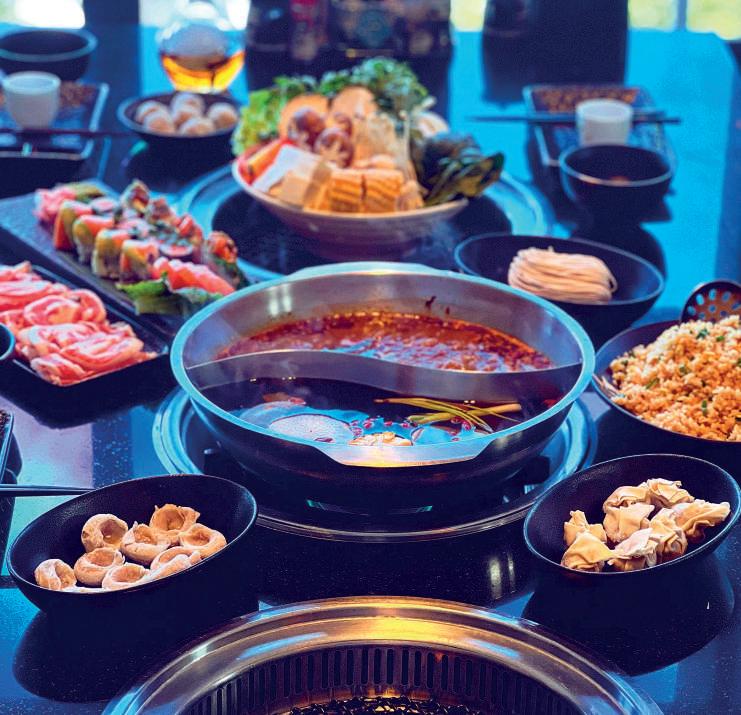
After such a rich and interactive main course, dessert might seem optional, but don’t skip it. The matcha ice cream was a subtle, cooling finish, while the fried bao with condensed milk offered a playful, indulgent end to the meal.
Biru leaves a lasting impression, not only for its food but for the experience it creates. It’s the kind of restaurant that turns dining into an occasion, where everyone at the table becomes part of the culinary performance.

Biru is more than a restaurant - it’s a celebration of shared meals, bold flavours, and cross-cultural connection. Whether you’re marinating meat over glowing coals or dipping tofu into fiery broth, the experience is tactile, personal, and deliciously memorable.
Perfect for adventurous foodies, date nights, and group outings, Biru brings something fresh and exciting to Johannesburg’s dining scene. Just be ready to play with your food - and love every minute of it.
Tues - Sat: 11:30am – 9pm Sun: 11:30am – 8pm Closed Mondays
Reservations recommended
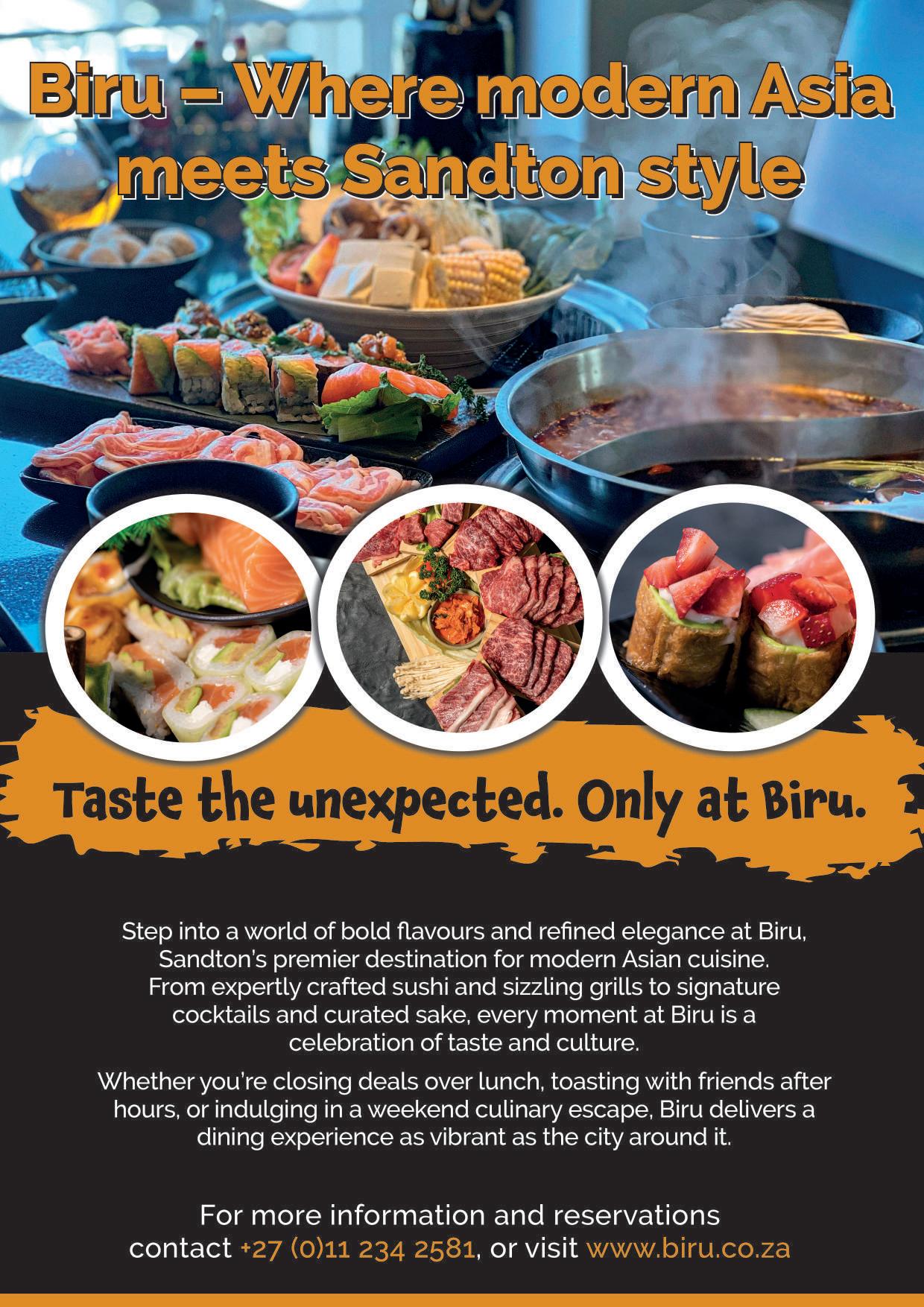

The Vine, the Vision, and the Voice:
Few figures in South African winemaking carry the kind of quiet authority and bold ambition that Elunda Basson does. With a career that spans the country’s most celebrated wine styles - from Cap Classique to bold reds and now, the crisp elegance of Sauvignon Blanc - she has built a reputation for both technical mastery and visionary leadership. Now, as Chairperson of Sauvignon Blanc South Africa, Basson is leading a fresh chapter for this dynamic cultivar.
In this candid conversation, she shares how her roots in the rugged Karoo and Namaqualand shaped her reverence for nature, her passion for innovation, and her vision to elevate South African Sauvignon Blanc onto the world’s premium stageicon wines, rockstar winemakers, and all.
Personal Journey & Background
You’ve had an impressive career spanning red winemaking, Cap Classique, and now Sauvignon Blanc. What initially drew you to winemaking?
I always knew I wanted to work in agriculture. The Boland area is renowned for its winelands, so I understood that I would need to specialise in wine if I wanted to work here. Little did I know just how big the world of wine actually is, and how much potential it holds for someone in the industry to travel the world.
Growing up in the Karoo and Namaqualand, how did your early experiences with nature and agriculture shape your approach to winemaking?
I have always appreciated and understood that Mother Nature is the giver of this fruit of the vine and that human intervention can only take it so far. If the quality is not in the fruit and the terroir, the quality will also never be in the wine. This is a very humbling realisation that keeps me grateful and very aware of my role in the winemaking process.
Sauvignon
As the new Chairperson of Sauvignon Blanc South Africa, what is your vision for the future of the cultivar?
I would like to see us continue to build on South Africa’s Sauvignon Blanc reputation and for South Africa to become a world player in the premium price points to elevate the status of this noble grape variety.
South African Sauvignon Blanc is seeing incredible growth in exports. What do you think sets it apart from other global Sauvignon Blanc styles?
In South Africa, we have a unique diversity of styles due to the diverse terroirs and microclimates that the grape is grown in. This diversity and regionality is something that we should really celebrate as our aroma profiles and styles are unique, offering great diversity to consumers all over the world.
Premiumisation is a key focus in your leadership. What strategies do you believe will elevate South African Sauvignon Blanc’s status on the world stage?
We should work on having clear and simple marketing messages that explain who we are and what we offer to an international consumer. We need strong brands to create quality wines in premium and super premium price points that can represent SA quality on a world stage and be unapologetic about its worth! We need icon wines and rockstar winemakers.
Innovation & Winemaking Techniques
You’ve worked extensively with both sparkling wine and Sauvignon Blanc. Are there any innovative winemaking techniques you’re particularly excited about?
Yes, being innovative and trying new things is very important. Exciting innovation in the use of different
yeasts and fermentation aids are always worthwhile investigating to keep up to speed with biotechnologies. It is also important to experiment with different styles of wine making. Even if it never makes it into the bottle, you are learning from it and formulating your own opinion of the differences, and how it works or not, with your terroir and your grapes.

The wine industry has traditionally been male-dominated. What challenges have you faced as a woman in winemaking, and how have you overcome them?
I think tough girls in male dominated industries enjoy the challenge of proving their worth and that they are as competent as their male peers. I’ve always tried to work hard, do my research and show up like I know what’s going on. Having the right attitude and showing confidence is critical but creating a network of women that support each other is equally important in this industry and something I’m passionate about.
Mentorship is something you’re passionate about. What advice do you have for young winemakers looking to break into the industry?
Find your passion, work hard at it, be confident and speak up. And, work hard at building a network of like-minded women that can support you in those tough moments.
Climate change is a growing concern in winemaking. How do you see it impacting South African Sauvignon Blanc in the coming years?
It will impact us and for that reason we need to make sure we plant the grape variety in the terroirs where it is most suited and most protected against extreme conditions. Regional identity is gaining momentum and focus, and it implies that we intentionally plant only the most suited grape varieties in our different microclimates so they can thrive in their environments, regardless of how challenging it might be. Moving forward, technology and innovation are going to be key for the success of our viticultural practices in an attempt to strive for a sustainable future.
Which global markets are most exciting for South African Sauvignon Blanc, and where do you see the biggest opportunities for growth? Currently, our 5 biggest export markets for Sblanc are the UK, Germany, Canada, USA and France. Although we’re already exporting about 60,5 million litres per annum, there is still potential for growth as this grape variety is the 8th most planted grape in the world.
Looking back on your career so far, what has been your proudest moment in winemaking? I’ve been blessed to have a few highlights. Awards and accolades can’t match the biggest thrill of all though and that is walking into a space where people are having a great meal with loved ones and seeing your bottle of wine at their table!!! Remains the biggest kick of all LV
Crafted from ancient Cape soils and shaped by ocean breezes, Black Swan is a definitive expression of our unique terroir. Refined, layered and age-worthy — a benchmark for South African Sauvignon Blanc.

NOT FOR SALE TO PERSONS UNDER THE AGE OF 18.

The fashion industry often walks a tightrope: on one side lies the promise of global recognition for fashion-forward designs and on the other, the lurking threat of imitation. In fashion, originality is everything. But creativity without protection, is an open door to imitation.
The Importance of Branding
It is well understood in fashion, that branding transforms a product from a mere item of clothing into a symbol of identity, status, and aspiration. A wellestablished trade mark carries with it a promise that resonates emotionally with consumers. Buyers don’t pay for an article per se – the quality of the fabric or the stitching – they invest in what the brand represents. This perceived value creates brand loyalty, even at a price premium and despite the fact that competing products offer similar quality, function or form. They say that, in fashion, the label often is the luxury.
The most valuable trade marks in fashion (rumoured to be Louis Vuitton, Nike, Chanel and Hermès – to name
but a few) have evolved into fashion power brands by ensuring that there is consistent quality, effective marketing, brand positioning, wide distribution footprint, and performance innovation.
The Intersection of Creativity and Innovation
Although fashion is mostly regarded as a purely aesthetic pursuit, in reality, it can be deeply technical and innovative. Designers are engineers of wearability and structure. This synergy is beautifully embodied in the designs of Salvatore Ferragamo: he rose to fame for the styling of luxury footwear, but he was also a prolific inventor, holding over 350 patents for everything from wedge heels to child-safe soles. His legacy illustrates
an important point: fashion is fertile ground for inventions and innovative designs.
Haute couture houses like Gucci, Chanel, and Dior understand this well. Gucci alone has registered hundreds of designs and inventions for handbags, watches, belts, and more. These registrations can be enforced, at least for a limited time, to keep copycats at bay and could form the backbone of licensing and other commercial transactions.
Fashion in the Virtual Age
While intellectual property (IP) rights have long been used to gain a competitive advantage in the fashion arena, more recently these rights are being tested in unprecedented

Dina Biagio
digital contexts. In a first case of its kind, Hermès took on NFT artist Mason Rothschild over his “MetaBirkins” collection - digital caricatures of the famous Birkin handbag rendered in faux fur and sold as NFTs. Rothschild argued that the project was art, shielded by free speech. Hermès contended that it was trade mark infringement.
Ultimately, the court agreed with Hermès. A jury found Rothschild had intentionally misled consumers into thinking the ‘digital bags’ were affiliated with the luxury brand. He was held liable for trade mark infringement, dilution, and cybersquatting
This case sent shockwaves through both the fashion and tech industries, illustrating in no uncertain terms, that real-world trademarks extend into the virtual world. Trade marks can be protected from unauthorised use, not only in boutiques or on billboards, but also on blockchain and digital art platforms.


While the metaverse presents new challenges, old ones persist in full force, especially with the rise of online commerce and side-hustle culture. Platforms like eBay, Amazon, Instagram, and TikTok have made it easy for anyone to launch a fashion storefront. But that accessibility has also supercharged the global trade in counterfeit goods. There can be no doubt that luxury knock-offs are big business. Counterfeits ride the coattails of brand reputation and consumer loyalty without bearing any of the costs of quality or innovation. As consumers chase luxury looks at discount prices, counterfeiters fill the gap by mimicking well-known labels at a fraction of the cost

Some online marketplaces, like eBay for example, have taken a clear and unequivocal stance on counterfeiting:
“We don’t allow counterfeit items or unauthorized copies to be listed on eBay. Items sold using a brand name or a brand logo must be original and made by the brand or manufactured on their behalf. Software, music, movies and other media must be original and not unauthorized copies.” Amazon now offers a brand registry for vendors to enrol their brands, together with relevant trade mark information. The registry has several benefits for both brand holders and consumers alike. Brand owners are empowered to police for infringement of their trademarks using proprietary


text and image searches on the platform. Amazon also uses advanced machine learning to implement “predictive protections” and then to block potentially infringing products from listing. Swift action against counterfeits enhances the credibility of the Amazon marketplace, which gives consumers the confidence to buy products without any nagging doubts as to their authenticity.
As fashion continues to evolve alongside innovation, the importance of intellectual property in protecting creativity will only deepen. Whether enforcing a monopoly in a technical innovation - wrinkle-resistant fabrics or wearable tech garments, for example - or protecting trade marks from infringement in the metaverse, the industry is learning to speak (a modern version of) the language of IP. Nowadays, fashion houses don’t need to tolerate digital freeloaders and the battle against counterfeits and fakes on e-commerce platforms is only just getting started. LV


A global weight loss boom, fuelled by miracle diabetes drugs, has led to an unexpected side effect: the ‘O weight loss face’, marked by hollowed cheeks, sagging jowls, and prematurely aged skin. In turn, this phenomenon has sparked a significant rise in demand for advanced facial rejuvenation, and particularly the deep plane facelift – what experts term ‘the facelift that lifts where it matters most’.
“One of the most common complaints I hear from patients is, ‘I finally have the body I wanted, but my face looks 10 years older,” says Professor Chrysis Sofianos, one of South Africa’s leading plastic surgeons and experts in deep plane facelifts.
The Gauteng-based specialist notes that he has seen a meteoric increase in consultations from patients seeking to reverse the facial deflation and laxity caused by rapid weight loss.
“This is just one instance where the deep plane facelift truly shines, as it restores natural facial harmony by lifting and repositioning deep tissues, not just tightening the skin. By addressing the deeper structural changes caused by significant weight loss,
this approach delivers far more natural outcomes and a timeless look.”
The facelift no one can see What sets the deep plane facelift apart? Unlike traditional facelifts that only address the skin’s surface, the deep plane technique lifts beneath the superficial musculoaponeurotic system (SMAS)
layer of tissue to reposition and support the foundational structures of the face. This approach not only rejuvenates the face more effectively than other techniques, but also avoids the tell-tale ‘pulled’ look, offering a more subtle, organic-looking transformation.
Professor Sofianos further enhances his results with the Vertical Restore method, lifting facial tissues vertically, or in harmony with the way in which gravity naturally impacts the face over time. This technique provides holistic rejuvenation of the midface, jawline, neck, and brow, with results that restore youthful contours and expressions.
“Only a handful of surgeons in Gauteng currently offer this breakthrough procedure, and I can confidently state that the deep plane facelift is the gold standard for natural, long-lasting revitalisation.”

According to Professor Sofianos, deep plane facelifts offer several major advantages compared to conventional facelifts:
• Superior, long-lasting results: By repositioning deeper facial structures rather than merely tightening the skin, the deep plane facelift offers longer-lasting, more authentic outcomes.
• Natural look and movement: The technique avoids excessive skin tension, ensuring the face remains expressive and vibrant –even in motion.
• Comprehensive rejuvenation: From sagging jowls and hollow cheeks to neck laxity, the deep plane facelift addresses multiple problem areas in one single, unified procedure.
The ultimate one-stop shop for aesthetic excellence and care Professor Sofianos’s practice is not only a leader in surgical innovation but

also a complete one-stop destination for all aesthetic needs. His clinic offers a full suite of surgical and non-surgical procedures, from advanced facial surgeries to injectables, laser treatments, skin rejuvenation, and body contouring. Each treatment is bespoke and delivered with meticulous care to ensure natural, balanced, and long-lasting results.
What truly sets Professor Sofianos apart, however, is his absolute commitment to patient care.
Every facelift is supported by a holistic pre- and post-operative care programme, designed to optimise recovery and results.
A signature component of this is the integration of hyperbaric oxygen therapy (HBOT), which is included as standard in his facelift packages. HBOT begins around 7-10 days after surgery, dramatically improving oxygen delivery to tissues, speeding up wound healing, reducing bruising and swelling, and significantly reducing overall healing times.
refined results that continue to improve for several months post-surgery.
“The success of a procedure isn’t just about the surgery itself, but about guiding patients through a complete journey from start to finish,” he explains. “My patients receive comprehensive, full-spectrum care, including pre-operative preparation, expert surgical techniques, post-operative hyperbaric therapy, scar management, and continuous follow-ups. It’s this level of commitment that ensures optimal outcomes, supporting patients through every step of their transformation and helping them feel comfortable and secure throughout.”

A lasting solution for facial rejuvenation in the weight loss era
As weight loss medications continue to help patients address issues with weight management and obesity, experts predict that the demand for facial rejuvenation will only rise.
“This trend has created both challenges and opportunities for plastic surgeons, and in many ways is reshaping our field in real time. The good news for patients is that we’re at the beginning of a new chapter in aesthetic medicine, where a combination of sophisticated surgical techniques and aftercare procedures are helping people achieve what was once thought impossible – natural-looking transformations that truly turn back the clock.”
As a result of these additional post-surgical interventions, the typical recovery period is two to three weeks, with most patients able to resume social activities within a month. With comprehensive aftercare – including HBOT and nutrient therapies – patients benefit from accelerated healing and
For those seeking to restore their youthful appearance with confidence and discretion, the deep plane facelift offers an unmatched, cutting-edge solution, delivered with precision, artistry, and unparalleled care by Professor Chrysis Sofianos and his dedicated team. LV

8 & 9 May
Prepare for a mind-expanding journey through space, sound, and storytelling as The Universe on Stage brings a reimagined production of their acclaimed show, Hidden Giants, back to the Joburg Theatre. Taking place for two nights only on May 8 and 9, this unique event blends cutting-edge science, breathtaking visuals, and live original music to explore one of the greatest mysteries of our universe: black holes.
Led by physicist Dr. Luca Pontiggia and composer Yasheen Modi (Yash), Hidden Giants invites audiences to step into the unknown, experiencing the cosmos through a fusion of immersive soundscapes, cinematic visuals, and expert storytelling.
Don’t miss this rare opportunity to experience Hidden Giants at the Joburg Theatre on May 8 & 9 at 19h30. Suitable for audiences of all ages (5+), this experience is perfect for anyone curious about the wonders of the universe. The show is about 90 minutes.
Tickets are available now at Webticket:https://www.webtickets.co.za/v2/event. aspx?itemid=1551349837

14 May - 7 June
THE DOLL’S HOUSE PART 2
Directed by Barbara Rubin from
Starring Bianca Amato, Zane Meas, Charlotte Butler and Simone Neethling
Presented by The Quickening Theatre Company, and Theatre on the Square, A Doll’s House, Part 2 is a bold, funny, and thought-provoking sequel to Henrik Ibsen’s classic play A Doll’s House. Written by Lucas Hnath, the play picks up 15

years after Nora Helmer famously slams the door on her husband and children to seek independence. The play presents a contemporary take on marriage, traditional roles, freedom, and the complexities of personal identity in a society that often resists change. With razor-sharp, modern dialogue and a wonderful mix of humour and drama, Hnath reimagines Ibsen’s timeless characters. Perfect for sparking conversations about marriage and independence. Expect the unexpected. You won’t regret it.
Book at Webtickets.
11 - 28 June
ATHOL FUGARD’S MASTER HAROLD AND THE BOYS
Directed by Warona Seane
Starring Sello Maake KaNcube, Daniel Anderson and Lebohang Motaung
Lighting and Set Design: Wilhelm Disbergen
We celebrate the work of South Africa’s most celebrated playwright after his most recent passing with a new production of the much loved Master Harold...and the Boys. The play
takes place in South Africa during apartheid in 1950. It depicts how institutionalised racism, bigotry or hatred can become absorbed by those who live under it. It is said to be a semiautobiographical play.
Not to be missed. Special School bookings available. Book at Webtickets.
1 July - 6 July
PRETORIA YOUTH THEATRE PRESENTS THE WIZARD OF OZ
Follow the Yellow Brick Road to Sandton’s Theatre on the Square.
Pretoria Youth Theatre proudly presents The Wizard of Oz, a dazzling stage production that brings L. Frank Baum’s beloved classic to life! Written and directed by Kerry-Anne Beldon and JP Kloppers, with Vocal Direction by Virtuous Kandemiri and produced by Clive Martin, this magical journey follows Dorothy, Scarecrow, Tin Man, and Lion as they venture through the Land of Oz. With enchanting music, spectacular costumes, and breathtaking performances, this production promises to capture the hearts of audiences young and old.
This heartwarming tale of friendship, courage, and self-discovery is perfect for the whole family. Expect dazzling choreography, toe-tapping songs, and, of course, a journey to meet the mysterious Wizard himself.
Book at Webtickets
10 - 27 July TRAMP
Charlie Chaplin musical starring Daniel Anderson
Written and Directed by Amanda Bothma Accompanied by Paul Ferreira
From the award-winning Wela Kapela team who brought you “Vincent” and “Mad About The Boys”together with Theatre on the Square, THE TRAMP is a one-man hybrid piece about the life of the greatest comic of the silent film era, Charlie Chaplin. The life of Chaplin is closely woven through his beloved Tramp character where the line between comedy and tragedy is often blurred. The story begs the question: who came first? Charlie or The Tramp? Accompanied by a timeless soundscape of honkey-tonk music and some musical numbers composed by Chaplin himself, among others. Book on Webtickets.
29 July - 10 Aug
NIK RABINOWITZ’S GERIATRIC MILLENIAL
This winter, comedian NIK RABINOWITZ hobbles triumphantly back to Sandton’s Theatre on the Square to bring you his new stand-up special “GERIATRIC MILLENNIAL» –because nothing says “comedy gold” like a generation that remembers dial-up internet sounds but can’t



remember if they took their statins last night.
Join Nik as he navigates the treacherous terrain of middle-aged millennial life, like refusing to buy reading glasses (while changing his phone’s font size to “LEGALLY BLIND”) and struggling to play padel with a “dicky knee” that was surgically butchered in the mid-90s. (“It’s never quite been the same» – a phrase he now uses to describe his knee, his sex life, AND his relationship with lactose).
Laugh until your back spasms! Book on Webtickets.
11 - 24 Aug
Directed by Aidan Scott Starring Brent Palmer and Jock Kleynhans
The Dumb Waiter is a one-act play by Harold Pinter written in 1957. In the dimly lit recesses of a desolate basement, two hitmen, Gus and Ben, await their next assignment, immersing audiences in a suffocating atmosphere of suspense and tension. The play is often called “The greatest oneact” of our time.

At the heart of this production is a stellar cast and crew dedicated to bringing Pinter’s early masterpiece to life. Brent Palmer, the award-winning actor, writer and producer, takes on the role of Ben with complexity and nuance. Opposite Palmer, Jock Kleynhans takes in the role of Gus.
Guiding this exceptional cast is director Aidan Scott. Book at Webtickets

